H1N1 spreading ways. H1N1 Influenza: Symptoms, Causes, and Global Impact of Swine Flu
What are the primary symptoms of H1N1 influenza. How does H1N1 flu spread between humans. What was the historical impact of the 1918 and 2009 H1N1 pandemics. How is the H1N1 virus structured and how does it mutate.
Understanding H1N1 Influenza: A Comprehensive Overview
H1N1 influenza, commonly known as swine flu, is a subtype of influenza A virus that has had significant global impact throughout history. This highly communicable viral illness primarily affects the respiratory tract, causing a range of symptoms from mild to severe. To fully grasp the importance of H1N1 influenza, it’s crucial to examine its characteristics, transmission methods, and historical significance.
What is H1N1 Influenza?
H1N1 influenza is a respiratory disease caused by influenza A viruses. Originally found in pigs, certain strains have adapted to spread among humans. The “H1N1” designation refers to the specific types of surface proteins found on the virus: hemagglutinin (H) and neuraminidase (N).
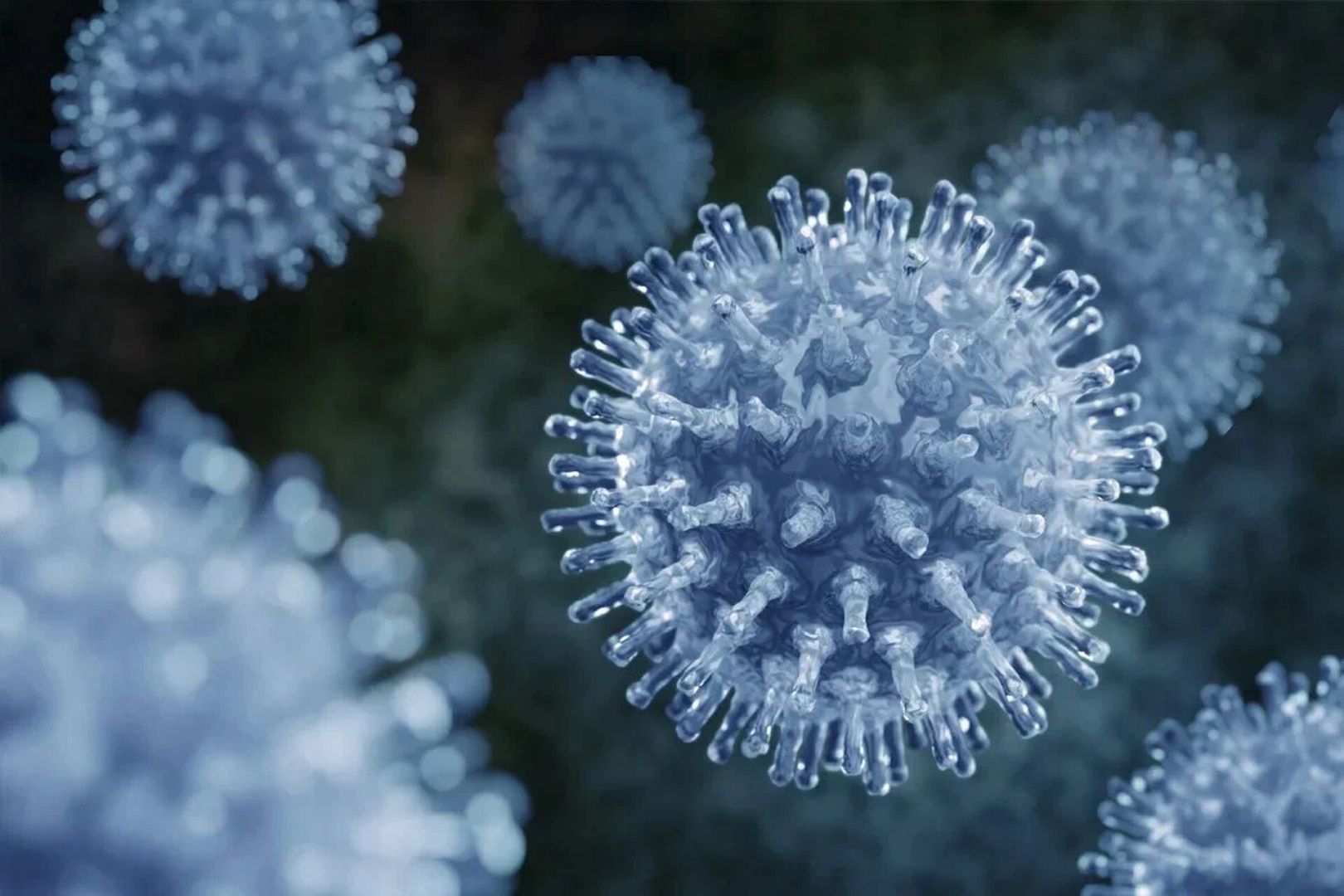
Common Symptoms of H1N1 Influenza
H1N1 influenza typically manifests with the following symptoms:
- Nasal secretions
- Chills
- Fever
- Decreased appetite
- Cough
- Body aches
- Fatigue
In some cases, lower respiratory tract infections may occur, leading to more severe complications.
The Historical Impact of H1N1 Influenza Pandemics
H1N1 influenza has been responsible for two major pandemics in recent history, each with significant global consequences.
The 1918 Spanish Flu Pandemic
The 1918 influenza pandemic, caused by an H1N1 virus, was one of the deadliest outbreaks in human history. How severe was this pandemic? It infected approximately 500 million people worldwide and resulted in an estimated 50 to 100 million deaths, representing 3% to 5% of the world’s population at the time. The scale and impact of this pandemic underscored the potential devastation that influenza viruses can cause.
The 2009 Swine Flu Pandemic
In 2009, a new strain of H1N1 influenza emerged, quickly spreading around the world. This outbreak was notable for its rapid transmission among humans, leading the World Health Organization (WHO) to declare it a pandemic. Unlike traditional swine flu, which typically spreads from pigs to humans, the 2009 H1N1 virus was transmitted directly between humans through airborne droplets and contact with contaminated surfaces.

Transmission and Spread of H1N1 Influenza
Understanding how H1N1 influenza spreads is crucial for preventing outbreaks and protecting public health.
Human-to-Human Transmission
H1N1 influenza primarily spreads through respiratory droplets when an infected person coughs, sneezes, or talks. These droplets can travel through the air and be inhaled by nearby individuals. Additionally, the virus can spread through contact with contaminated surfaces, where it may survive for several hours.
Zoonotic Transmission
While human-to-human transmission is now the primary concern for H1N1 influenza, the virus originally spread from pigs to humans. People in close contact with pigs, such as farm workers or veterinarians, may be at higher risk for zoonotic transmission of swine flu strains.
The Structure and Mutation of H1N1 Virus
The H1N1 influenza virus has a complex structure that contributes to its ability to infect hosts and evade immune responses.
Viral Structure
H1N1 influenza viruses are orthomyxoviruses with the following characteristics:
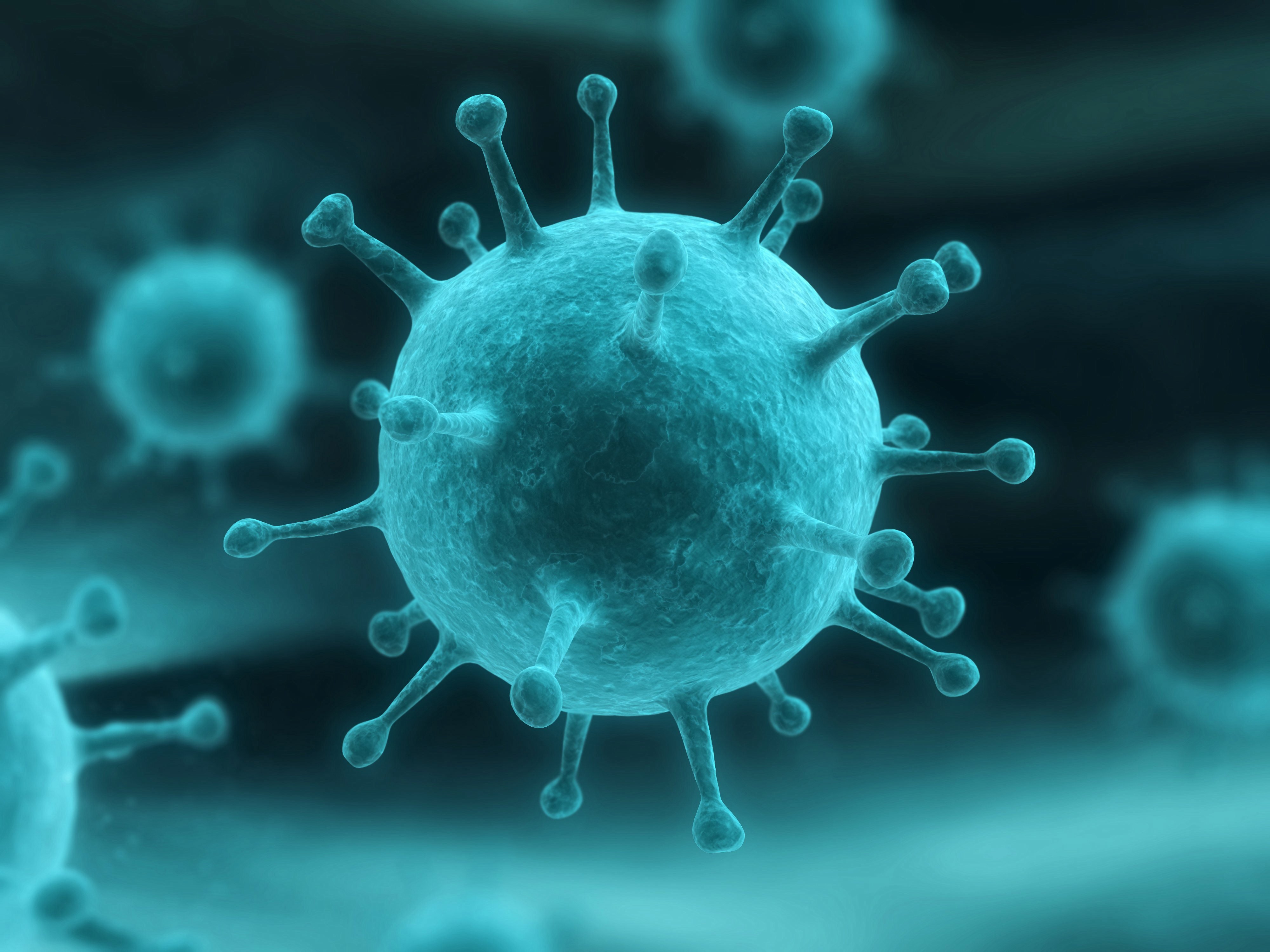
- 80 to 120 nm in diameter
- RNA genome approximately 13.5 kb in size
- 8 segmented regions encoding 11 different proteins
Key Viral Proteins
The H1N1 virus contains several important proteins that contribute to its function and virulence:
- Hemagglutinin (HA): Causes red blood cells to cluster and attaches the virus to infected cells
- Neuraminidase (NA): Aids in virus particle movement and budding from host cells
- Viral RNA polymerases: Include PB2, PB1, PB1-F2, PA, and PB
- Matrix proteins: M1 and M2
- Nonstructural proteins: NS1 and NS2 (NEP), crucial for efficient pathogenesis and viral replication
Viral Mutation and Reassortment
One of the reasons H1N1 influenza remains a concern is its ability to mutate and reassort its genetic material. How does this process occur? When different strains of influenza viruses infect the same host, they can exchange genetic segments, leading to the creation of new viral strains. This process, known as antigenic shift, can result in viruses with altered characteristics, potentially making them more transmissible or virulent.
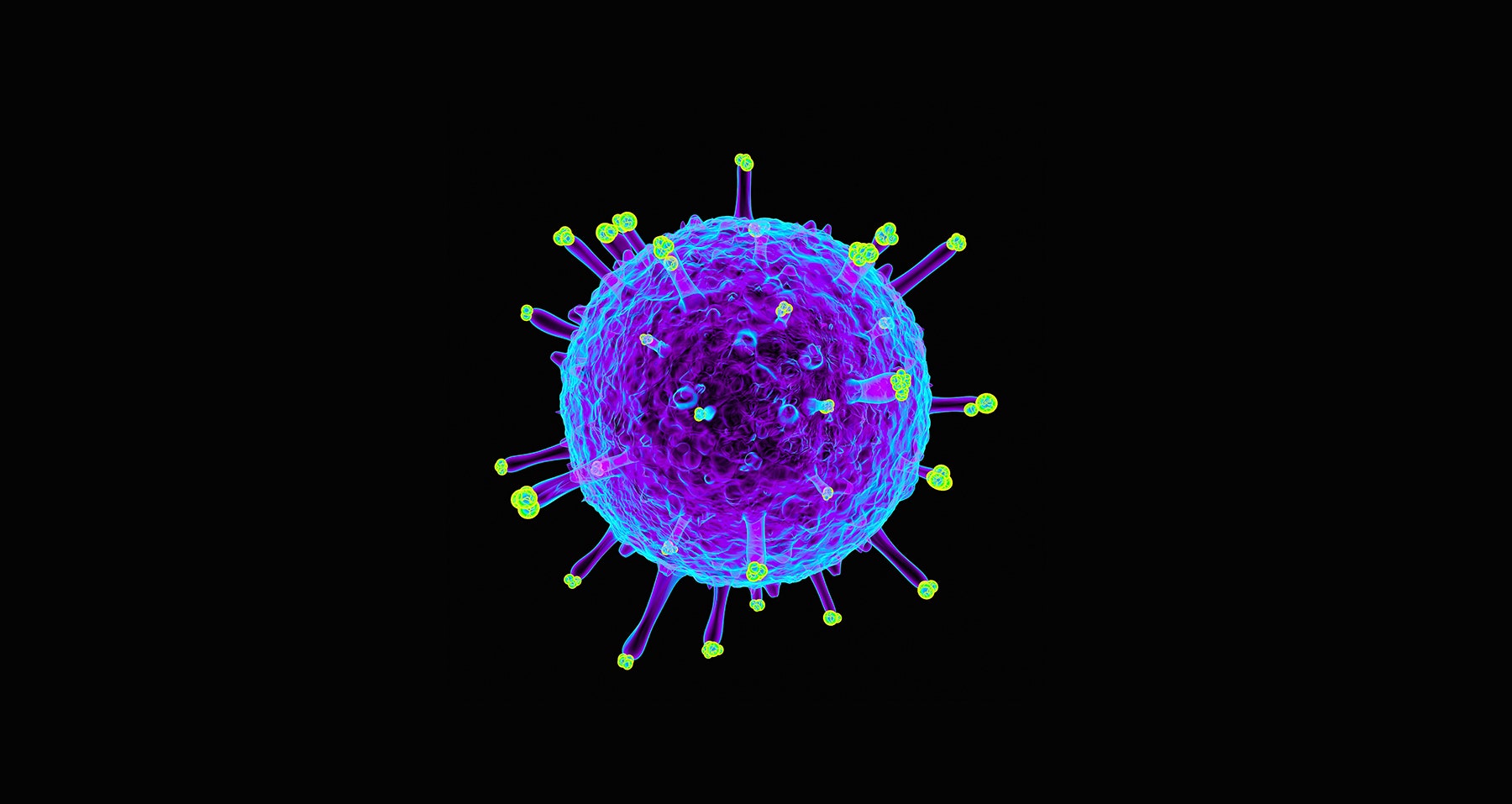
The 2009 H1N1 pandemic strain is a prime example of this genetic reassortment. It contained a combination of gene segments from four different influenza viruses:
- North American avian influenza (34.4%)
- Human influenza strain (17.5%)
- North American swine influenza (30.6%)
- Eurasian swine influenza (17.5%)
This unique combination allowed the virus to spread efficiently between humans while retaining characteristics from its diverse origins.
Prevention and Control of H1N1 Influenza
Given the potential for H1N1 influenza to cause widespread illness, prevention and control measures are essential for public health.
Vaccination
Vaccination remains the most effective method for preventing H1N1 influenza. Annual flu vaccines are designed to protect against the most common and predicted strains of influenza, including H1N1. These vaccines stimulate the immune system to produce antibodies against the virus, reducing the likelihood of infection or severe illness if exposed.
Hygiene and Infection Control
Simple hygiene practices can significantly reduce the spread of H1N1 influenza:

- Frequent hand washing with soap and water
- Using alcohol-based hand sanitizers when soap and water are unavailable
- Covering the mouth and nose when coughing or sneezing
- Avoiding close contact with infected individuals
- Staying home when sick to prevent spreading the virus to others
Environmental Measures
Regularly cleaning and disinfecting frequently touched surfaces can help reduce the spread of H1N1 influenza in homes, workplaces, and public spaces. This includes doorknobs, countertops, keyboards, and phones.
Diagnosis and Treatment of H1N1 Influenza
Proper diagnosis and treatment of H1N1 influenza are crucial for managing individual cases and preventing further spread of the virus.
Diagnostic Methods
H1N1 influenza is typically diagnosed through a combination of clinical symptoms and laboratory tests. Common diagnostic methods include:
- Rapid influenza diagnostic tests (RIDTs)
- Reverse transcription polymerase chain reaction (RT-PCR) tests
- Viral culture
These tests can detect the presence of influenza A viruses and, in some cases, specifically identify H1N1 strains.
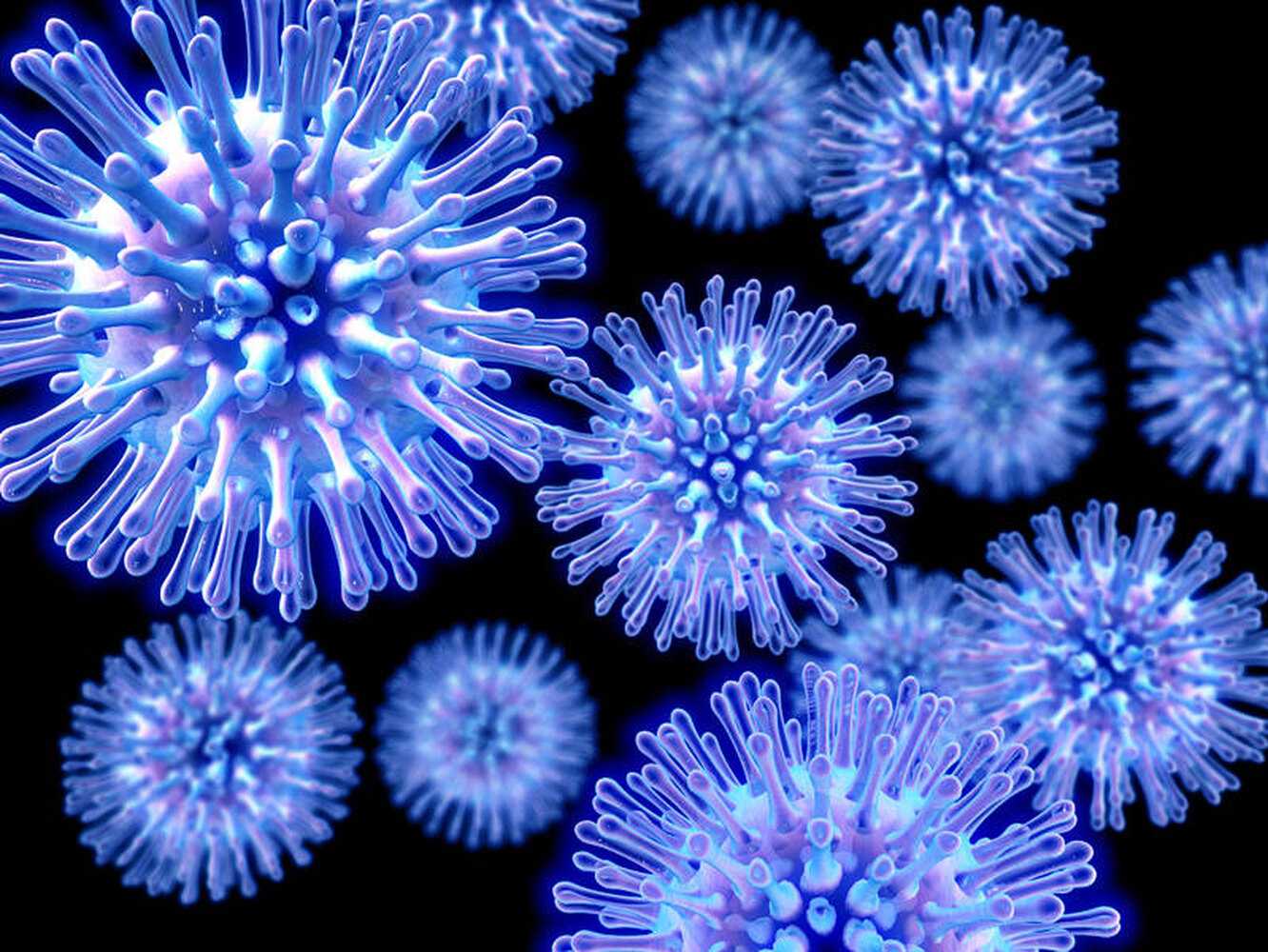
Antiviral Medications
Antiviral drugs play a crucial role in treating H1N1 influenza. These medications can help reduce the severity and duration of symptoms, as well as prevent complications. Commonly prescribed antivirals for H1N1 influenza include:
- Oseltamivir (Tamiflu)
- Zanamivir (Relenza)
- Peramivir (Rapivab)
- Baloxavir marboxil (Xofluza)
These drugs are most effective when started within 48 hours of symptom onset.
Supportive Care
In addition to antiviral treatment, supportive care is essential for managing H1N1 influenza symptoms. This may include:
- Rest and hydration
- Over-the-counter pain relievers and fever reducers
- Cough suppressants
- In severe cases, hospitalization for respiratory support or treatment of complications
The Role of Public Health Measures in Controlling H1N1 Outbreaks
Public health measures play a critical role in controlling the spread of H1N1 influenza during outbreaks and pandemics.
Surveillance and Monitoring
Effective surveillance systems are crucial for early detection and response to H1N1 outbreaks. This involves:
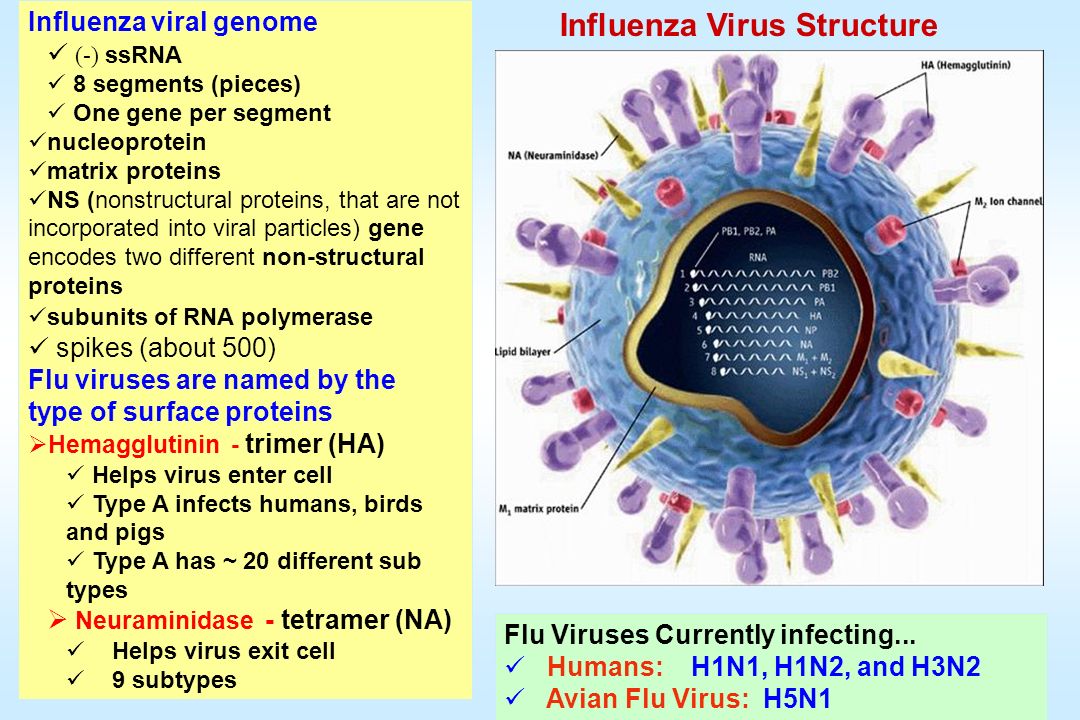
- Monitoring influenza-like illness rates in communities
- Laboratory testing to identify circulating strains
- Tracking antiviral resistance patterns
- International collaboration to share data and monitor global trends
Public Education and Communication
Clear and timely communication with the public is essential during H1N1 outbreaks. Public health authorities focus on:
- Providing accurate information about the virus and its spread
- Promoting preventive measures such as vaccination and hygiene practices
- Addressing misconceptions and combating misinformation
- Offering guidance on when to seek medical care
Social Distancing and Quarantine Measures
During severe outbreaks, social distancing and quarantine measures may be implemented to reduce transmission. These can include:
- School and workplace closures
- Cancellation of mass gatherings
- Travel restrictions
- Isolation of infected individuals and quarantine of close contacts
Future Challenges and Research Directions in H1N1 Influenza
As H1N1 influenza continues to evolve, researchers and public health officials face ongoing challenges in prevention, treatment, and preparedness.

Improving Vaccine Effectiveness
Enhancing the effectiveness of influenza vaccines remains a priority. Current research focuses on:
- Developing universal flu vaccines that provide broader protection against multiple strains
- Improving vaccine production methods to allow for faster response to emerging strains
- Enhancing vaccine uptake through education and accessibility initiatives
Antiviral Resistance
The emergence of antiviral-resistant H1N1 strains poses a significant challenge. Ongoing efforts include:
- Monitoring resistance patterns in circulating viruses
- Developing new antiviral drugs with novel mechanisms of action
- Investigating combination therapies to reduce the risk of resistance
Pandemic Preparedness
Improving global preparedness for future H1N1 pandemics is crucial. Key areas of focus include:
- Enhancing early warning systems and global surveillance networks
- Strengthening healthcare infrastructure and capacity
- Developing and stockpiling medical countermeasures
- Improving coordination between national and international health agencies
By addressing these challenges and continuing research efforts, the global community can better prepare for and respond to future H1N1 influenza outbreaks and potential pandemics.
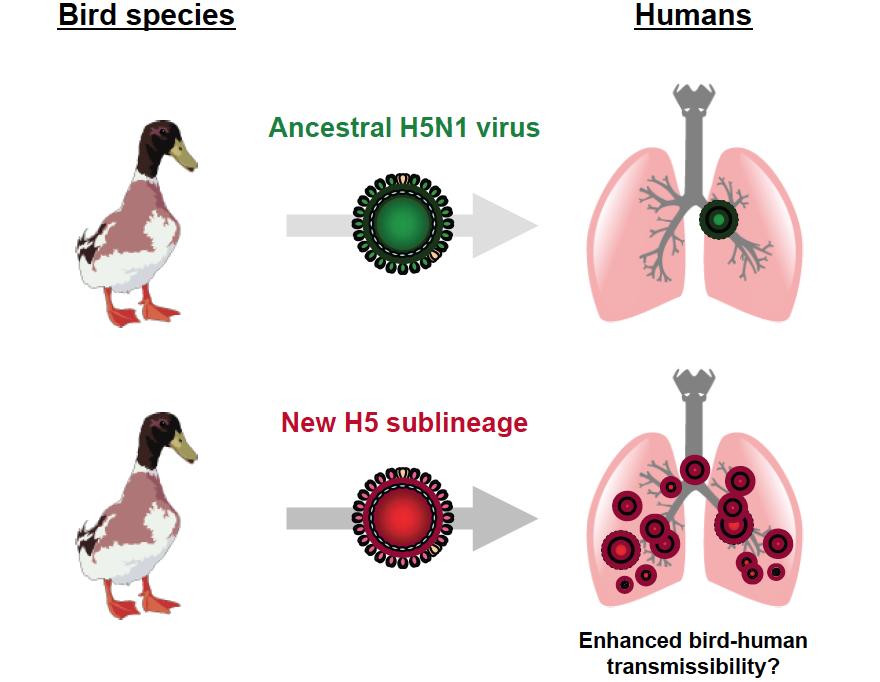
h2N1 Influenza – StatPearls – NCBI Bookshelf
Continuing Education Activity
h2N1 influenza is a subtype of influenza A virus, a communicable viral illness which causes upper and in some cases lower respiratory tract infections in its host. This results in symptoms such as nasal secretions, chills, fever, decreased appetite, and in some cases, lower respiratory tract disease. This activity reviews the presentation, evaluation, and management of h2N1 influenza and stresses the role of an interprofessional team approach to the care of affected patients.
Objectives:
Identify the global, historical impact of h2N1 influenza.
Summarize the transmission of h2N1 influenza.
Describe the common symptoms associated with h2N1 influenza.
Explain the importance of improving care coordination, with particular emphasis on communication between interprofessional medical teams, to enhance prompt and thorough delivery of care to patients with h2N1 influenza and prevent further disease spread.

Access free multiple choice questions on this topic.
Introduction
h2N1 Swine flu is a subtype of influenza A virus (a communicable viral disease), which causes upper, and potentially, lower respiratory tract infections in the host it infects, resulting in symptoms such as nasal secretions, chills, fever, decreased appetite, and possibly lower respiratory tract disease. h2N1 swine influenza is a common infection in pigs worldwide, and that is why it is also known as swine flu. h2N1 swine flu leads to respiratory disease that can potentially infect the respiratory tract of pigs. Sometimes, people who are closely associated with pigs or in the proximity of pigs have developed swine flu (zoonotic swine flu). Swine influenza viruses can potentially cause infections in humans if antigenic characteristics of the virus change through reassortment. When this happens, transmission from person-to-person is usually inefficient. Influenza A pandemics such as the ones in 1918 and 2009 can occur if the transmission from person-to-person becomes efficient. [1]
[1]
In 1918, a deadly influenza pandemic caused by h2N1 influenza virus, also known as the Spanish flu, infected approximately 500 million people around the world and resulted in the deaths of 50 to 100 million people (3% to 5% of the world population) worldwide, distinguishing it as one of the most deadly pandemics in human history. In 2009, a new strain h2N1 swine flu spread fast around the world among humans, and the World Health Organization (WHO) labeled it a pandemic. However, the 2009 h2N1 virus was not zoonotic swine flu because it was not transferred from pigs to humans. Instead, it spread through airborne droplets from human to human, and potentially, through human contact with inanimate objects contaminated with the virus and transferred to the eyes or nose. This virus caused similar symptoms to those seen in swine, possibly due to reassortment of the viral RNA structure, which allowed human-to-human transfer. [2][3]
Despite the name, an individual cannot acquire swine flu from eating pig products such as bacon, ham, and other pig products.
Etiology
The h2N1 influenza virus is an orthomyxovirus and produces virions that are 80 to 120 nm in diameter, with an RNA genome size of approximately 13.5 kb. The swine influenza genome has 8 different regions which are segmented and encode 11 different proteins:
Envelope proteins hemagglutinin (HA) and neuraminidase (NA)
Viral RNA polymerases which include PB2, PB1, PB1-F2, PA, and PB
Matrix proteins M1 and M2
Nonstructural proteins NS1 and NS2 (NEP), which are crucial for efficient pathogenesis and viral replication
The surface glycoproteins HA and NA are how the h2N1-strain is differentiated from other strains of influenza A (h2N1, h2N2) depending on the type of HA or NA antigens expressed with metabolic synergy. The function of hemagglutinin is to cause red blood cells to cluster together, and it attaches the virus to the infected cell. Neuraminidase helps move the virus particles through the infected cell and assists in budding from host cells.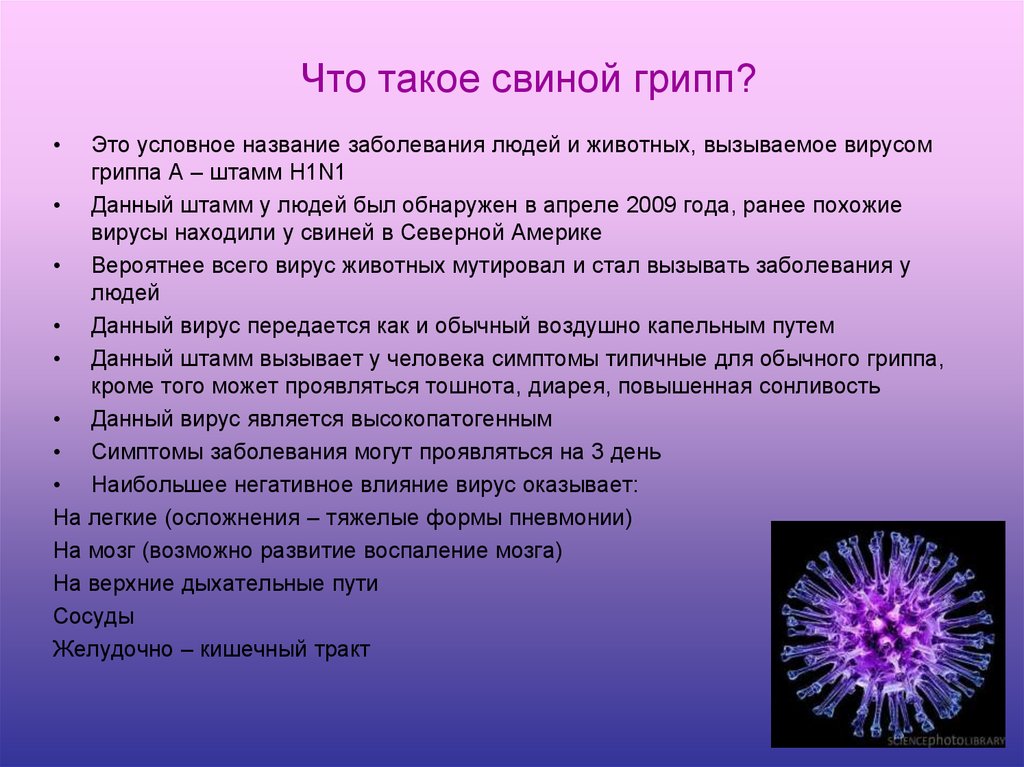
The h2N1 swine influenza viruses can potentially cause infections in humans if antigenic characteristics of the virus change. In 2009, the pandemic which started in Mexico with the h2N1 strain displayed a combination of segments of 4 different influenza viruses (quadruple genetic reassortment): pig-origin flu North American avian (comprising 34.4%), bird-origin flu of the human influenza strain (comprising 17.5%), North American swine (comprising 30.6%), and Eurasian swine (comprising 17.5%). Due to this coinfection with influenza virus from diverse animal species, the viruses were able to interact, mutate, and form new strains that had variable immunity. Although it had originated in pigs, it was able to spread from human to human. When the flu spreads from human-to-human, instead of from animals to humans, there can be further mutations, making it harder to treat because people have no natural immunity. [4][5][6]
Epidemiology
Swine flu was first isolated from pigs in the 1930s by researchers in the United States and was subsequently recognized by pork producers and veterinarians as a cause of flu infections in pigs worldwide, and for the next 60 years, h2N1 was the predominant swine influenza strain. People who are closely associated with pigs have been known to develop an infection, and pigs have also been infected with human flu from these handlers. In the vast majority of cases, cross-species transmission of the virus had remained confined to the specific area and not caused national or global infections in either pigs or humans. Unfortunately, due to the potential for genetic variation in the swine flu virus, there is always a possibility for cross-species transmission with the influenza viruses to occur. Investigators concluded that the “2009 swine flu” strain, which originated in Mexico, was termed novel h2N1 flu since it was mainly found infecting humans and exhibits 2 main surface antigens, hemagglutinin type 1 and neuraminidase type 1. The 8 RNA strands in novel h2N1 flu have 1 strand from human flu strains, 2 derived from avian (bird) strains, and 5 that were derived from swine strains. During the 2009 pandemic, the Centers for Disease and Control and Prevention (CDC) estimated that there were 43 to 89 million cases of swine flu reported during a 1-year span, with 1799 deaths in 178 countries worldwide.
People who are closely associated with pigs have been known to develop an infection, and pigs have also been infected with human flu from these handlers. In the vast majority of cases, cross-species transmission of the virus had remained confined to the specific area and not caused national or global infections in either pigs or humans. Unfortunately, due to the potential for genetic variation in the swine flu virus, there is always a possibility for cross-species transmission with the influenza viruses to occur. Investigators concluded that the “2009 swine flu” strain, which originated in Mexico, was termed novel h2N1 flu since it was mainly found infecting humans and exhibits 2 main surface antigens, hemagglutinin type 1 and neuraminidase type 1. The 8 RNA strands in novel h2N1 flu have 1 strand from human flu strains, 2 derived from avian (bird) strains, and 5 that were derived from swine strains. During the 2009 pandemic, the Centers for Disease and Control and Prevention (CDC) estimated that there were 43 to 89 million cases of swine flu reported during a 1-year span, with 1799 deaths in 178 countries worldwide. [7][8]
[7][8]
The 1918 deadly influenza pandemic caused by h2N1 influenza virus, infected approximately 500 million people around the world and caused the death of roughly fifty to a hundred million people. The h2N1 variant of swine flu is the progeny of the strain that caused the 1918 swine flu pandemic. Although persisting in pigs, the descendant variants of the 1918 virus have also known to infect humans, contributing to the yearly seasonal epidemics of influenza. Direct transmission of the virus from pigs to humans is a rare occurrence, with only 12 documented cases in the United States since 2005. The potential retention of influenza virus strains in swine after these strains have disappeared in the human population, essentially make pigs a reservoir where swine influenza viruses could persist, and later emerge to reinfect humans once their immunity to these strains has waned. [1][9]
More recently in 2015, a mutant strain of h2N1 which caused the global pandemic in 2009, spread across India with over 10,000 reported cases and 774 deaths.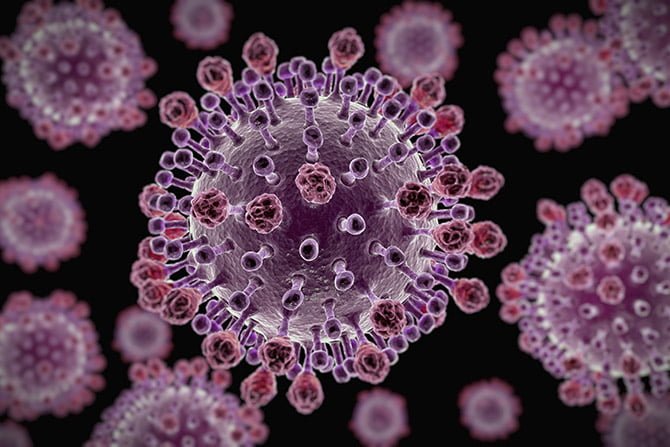
People who have a higher risk of becoming seriously ill if infected include:
Children younger than 5 years old
Adults older than age 65, younger adults, and children under age 19 who are on long-term aspirin therapy
People with compromised immune systems due to diseases such as AIDS
Currently gestating females
People suffering from chronic diseases such as asthma, heart disease, diabetes mellitus, or neuromuscular disease
Pathophysiology
h2N1 swine flu is an acute disease that infects the upper respiratory tract and can cause inflammation of the upper respiratory passages, trachea, and possibly the lower respiratory tract. The known incubation period for h2N1 swine flu ranges from 1 to 4 days, with the average around 2 days in most individuals, but some individuals, it may be as long as 7 days. The contagious period for adults starts about 1 day before symptoms develop and lasts around 5 to 7 days after the person develops symptoms. The contagious period may be longer in individuals with weakened immune systems and children (e.g., 10 to 14 days).
The contagious period may be longer in individuals with weakened immune systems and children (e.g., 10 to 14 days).
The acute symptoms of uncomplicated infections persist for three to seven days, and the disease is mostly self-limited in healthy individuals, but malaise and cough can persist for up to 2 weeks in some patients. Patients with more severe disease may require hospitalization, and this may increase the time of infection to around 9 to 10 days. The body’s immune reaction to the virus and the interferon response are the causes of the viral syndrome which includes high fever, coryza, and myalgia. Patients with chronic lung diseases, cardiac disease and who are currently pregnant are at higher risk of severe complications such as viral pneumonia, superimposed bacterial pneumonia, hemorrhagic bronchitis, and possibly death. These complications can potentially develop within 48 hours from the onset of symptoms. The replication of the virus occurs primarily in the upper and lower respiratory tract passages from the time of inoculation and peaks around 48 hours in most patients. The recommended time of isolation of the infected patient is around 5 days. [10]
The recommended time of isolation of the infected patient is around 5 days. [10]
Histopathology
Swine flu causes most symptoms in upper and lower respiratory tracts. Mild cases usually show a few pathologic changes in the respiratory tract, but severe cases can show clear pathologic changes of pneumonia. The pathological findings associated with swine flu include multifocal destruction and potential desquamation of the pseudo columnar and columnar epithelial cells, and possibly prominent hyperemia and edema in the submucosa. There may also be thrombus formation at the bronchiolar level. Sometimes, the acute inflammation could be severe and indicated by hemorrhagic tracheobronchitis and desquamative bronchiolitis, which could cause necrosis of the bronchiolar wall. Once necrosis occurs, polymorphs and mononuclear cells infiltrate into the affected area.
Histological changes in swine influenza pneumonia include: interstitial edema with possible inflammatory infiltrate, alveolar proteinaceous exudation associated with membrane formation, thrombosis of capillaries, necrosis of the alveolar septae, intra-alveolar hemorrhage, dislocation of desquamated pneumocytes with pyknotic nuclei into the surrounding alveolar spaces, diffuse alveolar damage with infiltration by the lymphocytes and histiocytes into the interstitium.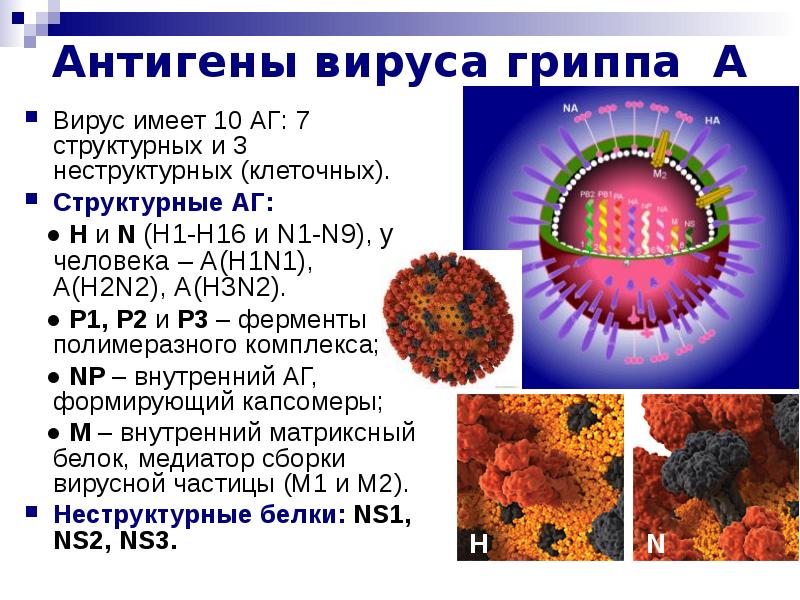 During the late stage, the following changes have been reported in patients: diffuse alveolar damage, fibrosis, hyperplasia of the type II pneumocyte, epithelial regeneration, and squamous metaplasia have been found. These changes are characteristic of the fibroproliferative stage of acute respiratory distress syndrome and diffuse alveolar destruction. Bacterial coinfections were also identified in some autopsy cases. The most common bacteria isolated included Streptococcus pneumoniae, Streptococcus pyogenes, Staphylococcus aureus, community-acquired, methicillin-resistant Staphylococcus aureus, and Haemophilus influenzae.
During the late stage, the following changes have been reported in patients: diffuse alveolar damage, fibrosis, hyperplasia of the type II pneumocyte, epithelial regeneration, and squamous metaplasia have been found. These changes are characteristic of the fibroproliferative stage of acute respiratory distress syndrome and diffuse alveolar destruction. Bacterial coinfections were also identified in some autopsy cases. The most common bacteria isolated included Streptococcus pneumoniae, Streptococcus pyogenes, Staphylococcus aureus, community-acquired, methicillin-resistant Staphylococcus aureus, and Haemophilus influenzae.
History and Physical
The history and clinical presentations of h2N1 swine influenza have ranged from mild flu symptoms to severe respiratory symptoms (and possibly death) depending on the age of the patient, co-morbidities, vaccination status, and natural immunity in patients to the virus. According to the CDC, the signs and symptoms in humans infected with the 2009 h2N1 swine flu were similar to those of influenza.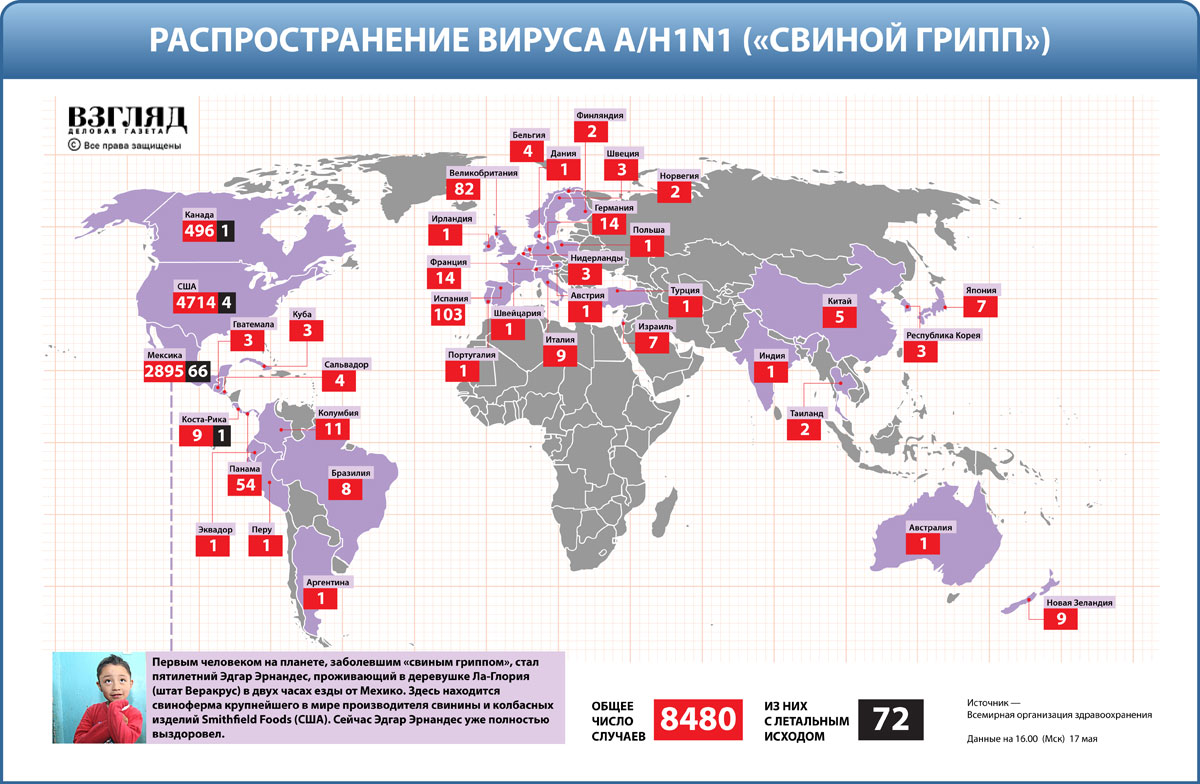 These include a fever and chills, cough, sore throat, congested eyes, myalgia, shortness of breath, weight loss, chills, sneezing, headache, rhinorrhea, coughing, dizziness, abdominal pain, decreased appetite, and fatigue. The 2009 h2N1 strain also showed an increased number of people reporting vomiting and diarrhea as well. Because most of these symptoms are not exclusive to swine flu, a detailed history must also be taken to take into account the differential diagnosis of swine flu if the patient has directly contacted someone with confirmed swine flu or has been in an area that had documented cases of swine flu. Respiratory failure was the most common cause of death in severe cases. Other causes included high fever (causing neurological problems), pneumonia (causing sepsis), dehydration and severe hypotension (from vomiting and diarrhea), electrolyte imbalance associated complications, and kidney failure. More severe cases and fatalities were more likely observed in children younger than 5 years of age and elderly patients older than 60 years.
These include a fever and chills, cough, sore throat, congested eyes, myalgia, shortness of breath, weight loss, chills, sneezing, headache, rhinorrhea, coughing, dizziness, abdominal pain, decreased appetite, and fatigue. The 2009 h2N1 strain also showed an increased number of people reporting vomiting and diarrhea as well. Because most of these symptoms are not exclusive to swine flu, a detailed history must also be taken to take into account the differential diagnosis of swine flu if the patient has directly contacted someone with confirmed swine flu or has been in an area that had documented cases of swine flu. Respiratory failure was the most common cause of death in severe cases. Other causes included high fever (causing neurological problems), pneumonia (causing sepsis), dehydration and severe hypotension (from vomiting and diarrhea), electrolyte imbalance associated complications, and kidney failure. More severe cases and fatalities were more likely observed in children younger than 5 years of age and elderly patients older than 60 years.
Other risk factors for severe disease include lung disorders such as chronic obstructive pulmonary disease (COPD), bronchial asthma, pneumonia, currently pregnant women, obesity, patients undergoing immunosuppressive therapy due to cancer or autoimmune disease, and underlying medical issues such as diabetes. Pregnant women acquired the infection during their third trimester were at greater risk for complications.
Evaluation
Influenza A (h2N1) virus infection could be encountered in a wide range of clinical settings and may result in variable pathologic findings. h2N1 should be one of the differential diagnosis in patients who present with unexplained flu-like symptoms or acute pneumonia in an area with known swine flu cases. Routine investigations should be performed for the patient who presents with these symptoms. These usually include hematological, microbiological, biochemical and radiologic tests. A respiratory sample (simple nose or throat swab) is required for a confirmed diagnosis of swine flu.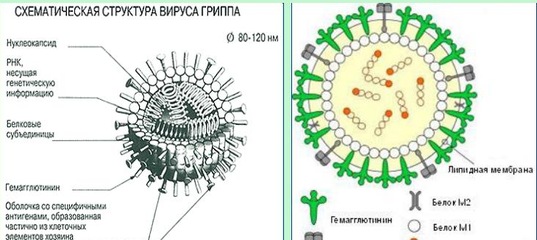 In humans, these tests include the Reverse transcriptase-polymerase chain reaction test (RT-PCR), virus isolation test, and assays to detect a 4-fold increase in influenza virus antigens. The routine tests done to detect human influenza viruses, including the rapid test kits, do not always detect zoonotic viruses.
In humans, these tests include the Reverse transcriptase-polymerase chain reaction test (RT-PCR), virus isolation test, and assays to detect a 4-fold increase in influenza virus antigens. The routine tests done to detect human influenza viruses, including the rapid test kits, do not always detect zoonotic viruses.
An indication that a novel, possibly zoonotic swine influenza virus could be present, is a detection of the influenza A virus, but not of the hemagglutinins in the seasonal human influenza viruses. The zoonotic influenza virus infections can sometimes be diagnosed retrospectively by serology, but potential cross-reactivity with human influenza viruses can complicate this diagnosis. Another concern is that the neuraminidase (NA) and hemagglutinin (HA) of some swine influenza viruses (the main target of the antibodies) originated from human influenza viruses, to which people could have already been exposed.
State, regional, and national public health laboratories do generally test for the novel influenza viruses.
Treatment / Management
The initial and best step in management should be to prevent swine flu. Specifically, with the prevention of swine flu in swine, prevention of transmission of swine flu from swine-to-humans, and prevention of human-to-human spread.
Prevention of swine flu in swine: Main methods to prevent swine flu in pigs involve facility management (using disinfectants and regulated temperature to control viruses in the environment), herd management (not adding pigs possibly carrying influenza to the herds that have not yet been exposed to the virus), and vaccination. As much of the morbidity and mortality observed with swine flu is due to secondary infection by other pathogens, strategies that solely rely on vaccination may be insufficient.
Prevention of swine to human viral transmission: Because swine can be infected with avian and human strains of h2N1 influenza, they are the primary hosts where antigenic shifts occur that can cause new strains of swine flu.
 Transmission of the influenza virus from swine to humans is usually seen in people who have a close association with pigs, such as farmers, pork handlers, and veterinarians. These individuals are strongly encouraged to wear face-masks when dealing with the animals to prevent transmission through respiratory droplets. The most important step of prevention is vaccination of the swine. Individuals with increased risk of acquiring swine flu through pigs are those who smoke and do not wear gloves or masks when dealing with infected animals, increasing the risk of possible hand-to-nose, hand-to-eye, or hand-to-mouth transmission.
Transmission of the influenza virus from swine to humans is usually seen in people who have a close association with pigs, such as farmers, pork handlers, and veterinarians. These individuals are strongly encouraged to wear face-masks when dealing with the animals to prevent transmission through respiratory droplets. The most important step of prevention is vaccination of the swine. Individuals with increased risk of acquiring swine flu through pigs are those who smoke and do not wear gloves or masks when dealing with infected animals, increasing the risk of possible hand-to-nose, hand-to-eye, or hand-to-mouth transmission.Prevention of human to human transmission: The main route of swine flu virus spread between humans is exposure to the virus when someone infected sneezes or coughs, and the virus enters one of the potential mucous surfaces, or when a person touched something infected with the virus and subsequently touch their nose, mouth, and surrounding areas. Swine flu is most contagious in the first 5 days of illness in most people, although this may increase in children and the elderly.
 Current CDC recommendations to prevent the spread of the virus include frequent handwashing with soap and water or alcohol-based sanitizers, and also disinfecting household, hospital and public settings by cleaning with a diluted bleach solution. Anyone who resides in an area where the disease is prevalent and suspects an infection or presents with flu-like symptoms, should stay away from work and public transportation and immediately see a doctor.
Current CDC recommendations to prevent the spread of the virus include frequent handwashing with soap and water or alcohol-based sanitizers, and also disinfecting household, hospital and public settings by cleaning with a diluted bleach solution. Anyone who resides in an area where the disease is prevalent and suspects an infection or presents with flu-like symptoms, should stay away from work and public transportation and immediately see a doctor.
The best-known prevention method against swine flu is getting the h2N1 swine flu vaccine. In September 2009, the FDA permitted the new swine flu vaccine, and various studies by the National Institute of Health (NIH) showed that a single dose was enough to create sufficient antibodies to protect against the virus within 10 days. The vaccination is contraindicated in people who had a previous severe allergic reaction to the influenza vaccination. Those who are moderate to severely ill, including those with or without a fever, should take the vaccination when they recover or are asymptomatic.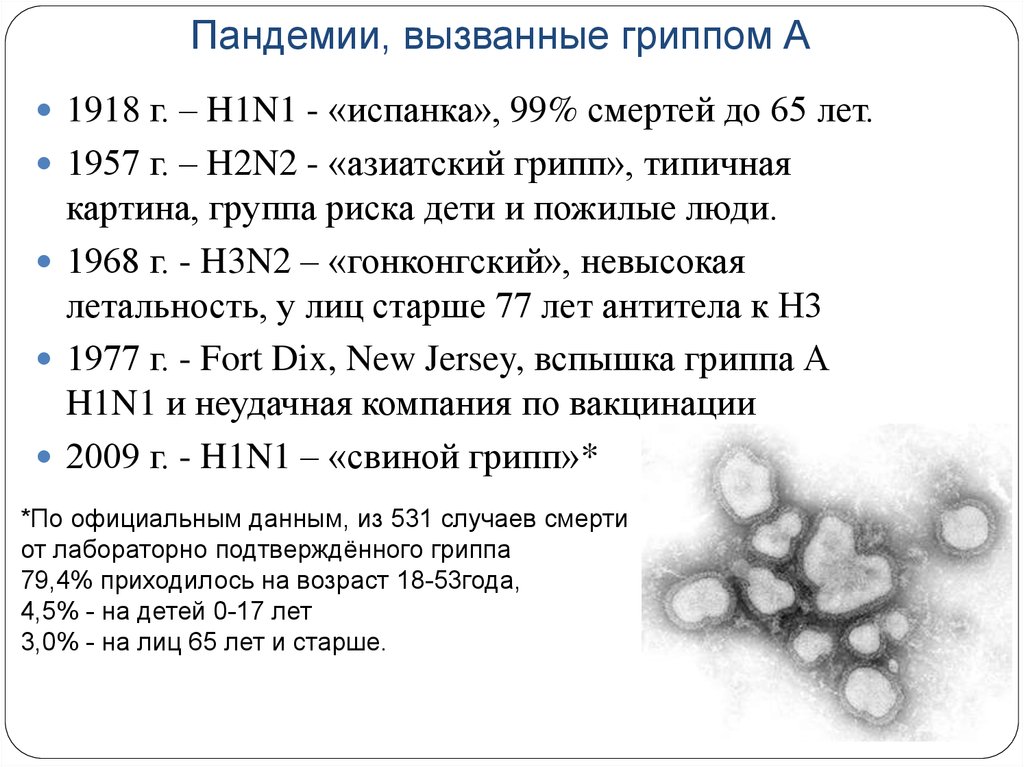
The management for infected patients depends on the severity of symptoms of influenza, mild to moderate influenza can be treated at home with rest, oral hydration and symptomatic treatment with antipyretics like paracetamol, antihistaminic for nasal congestion and rhinitis and NSAIDS or Paracetamol for headaches and body aches. Patients with progressive or severe symptoms should be admitted to hospitals and preferably in intensive care units (ICU) if there are signs suggestive of impending respiratory failure or sepsis or multiorgan dysfunction. Aggressive supportive measures like intravenous (IV) hydration, correction of electrolyte imbalances, antibiotics for concomitant bacterial infections. Patients developing acute respiratory distress syndrome (ARDS) secondary to influenza should be treated with noninvasive or invasive mechanical ventilation. Severe cases of h2N1-induced ARDS have required the use of extracorporeal membrane oxygenation (ECMO).
The antiviral medications: zanamivir, oseltamivir, and peramivir have been documented to help reduce, or possibly prevent, the effects of swine flu if the medication is taken within 48 hours of the onset of symptoms. Known side effects of oseltamivir comprise skin conditions that are occasionally severe and sporadic transient neuropsychiatric events. These possible side effects are the reason the use of oseltamivir is cautioned in the elderly and individuals that have a higher risk of developing these side effects. An allergy to eggs is the only contraindication to zanamivir. Beginning October 1, 2008, the CDC tested 1146 seasonal influenza A (h2N1) collected viruses for resistance to the drugs oseltamivir and zanamivir. It concluded that 99.6% of the samples showed resistance to oseltamivir while none showed resistance to zanamivir. Of the 853 collected samples of the 2009 influenza A (h2N1) virus, only 4% demonstrated resistance to oseltamivir, while none of the 376 samples collected showed resistance to zanamivir.
Known side effects of oseltamivir comprise skin conditions that are occasionally severe and sporadic transient neuropsychiatric events. These possible side effects are the reason the use of oseltamivir is cautioned in the elderly and individuals that have a higher risk of developing these side effects. An allergy to eggs is the only contraindication to zanamivir. Beginning October 1, 2008, the CDC tested 1146 seasonal influenza A (h2N1) collected viruses for resistance to the drugs oseltamivir and zanamivir. It concluded that 99.6% of the samples showed resistance to oseltamivir while none showed resistance to zanamivir. Of the 853 collected samples of the 2009 influenza A (h2N1) virus, only 4% demonstrated resistance to oseltamivir, while none of the 376 samples collected showed resistance to zanamivir.
Pregnant women who contract the h2N1, are at a greater risk of complications because of the body’s hormonal changes, physical changes and changes to their immune system to accommodate the growing fetus. For these reasons, the CDC recommends that all pregnant women get vaccinated to prevent the swine influenza virus. Swine influenza in pregnant women can be treated using antiviral medications: oseltamivir and zanamivir (neuraminidase inhibitors). It has been demonstrated that these 2 drugs are most effective when taken within 2 days of becoming sick. [11][12][13]
For these reasons, the CDC recommends that all pregnant women get vaccinated to prevent the swine influenza virus. Swine influenza in pregnant women can be treated using antiviral medications: oseltamivir and zanamivir (neuraminidase inhibitors). It has been demonstrated that these 2 drugs are most effective when taken within 2 days of becoming sick. [11][12][13]
Differential Diagnosis
Adenovirus
Arenaviruses
Cytomegalovirus
Dengue
Echovirus infection
Prognosis
Evaluation of data reveals that some patients admitted with swine flu are at risk for sepsis, ARDS and death. Predictors of death include chronic lung disease, obesity, underlying neurological diseases, delayed admission, and other co-morbidity.
Enhancing Healthcare Team Outcomes
Swine flu is very contagious and is easily spread from humans after contact with pigs. The infection rapidly leads to moderate to severe symptoms and deaths are not rare. The key is to prevent the infection in the first place.
The key is to prevent the infection in the first place.
For best results, an interprofessional team should provide for the evaluation and care of patients with Swine flu. The team should be aware of patients at a high risk of becoming seriously ill if infected including you children, the elderly, those immunocompromized, gestating females, and those suffering from chronic debilitating diseases.
Today, the primary care provider, pharmacist and nurse practitioner should recommend the h2N1 vaccine to children and adults at risk. In addition, all pregnant women should be urged to get vaccinated to prevent the high mortality of the infection. The school nurse should encourage closure of the school even if only one case of h2N1 is identified. Parents should be encouraged to get the children vaccinated and prevent them from interacting with others; pharmacists are empowered to perform this function in many US states. In the hospital, the nurses should ensure that the patient is in a single isolation room with airborne precautions in place.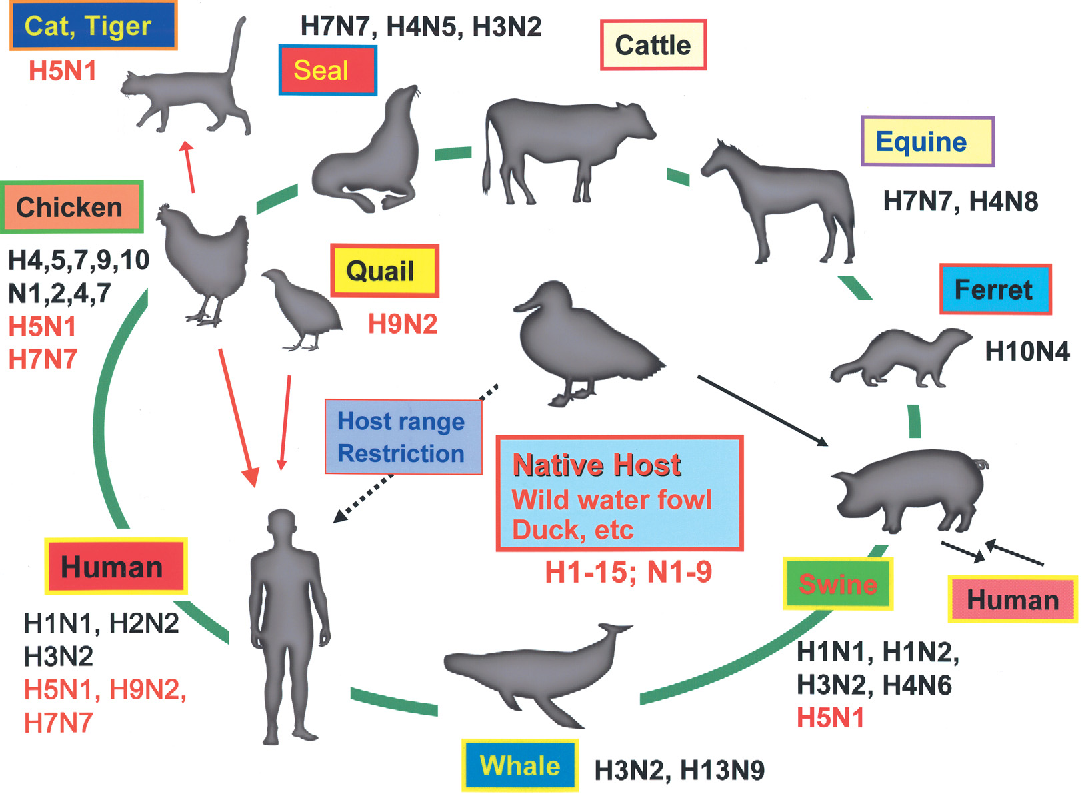 Appropriate precautions have to be undertaken to prevent contact with body fluids and aerosols released in the air while coughing. Hand washing should be enforced and only a limited number of healthcare personnel should be allowed to come into contact with the infected person. Only through open communication among members of the interprofessional team can the morbidity and mortality of swine flu be reduced. [14][Level 5]
Appropriate precautions have to be undertaken to prevent contact with body fluids and aerosols released in the air while coughing. Hand washing should be enforced and only a limited number of healthcare personnel should be allowed to come into contact with the infected person. Only through open communication among members of the interprofessional team can the morbidity and mortality of swine flu be reduced. [14][Level 5]
Review Questions
Access free multiple choice questions on this topic.
Comment on this article.
Figure
Digitally-colorized transmission electron microscopic (TEM),h2N1 influenza virus particles. Contributed by the Public Health Image Library (PHIL)
References
- 1.
Kshatriya RM, Khara NV, Ganjiwale J, Lote SD, Patel SN, Paliwal RP. Lessons learnt from the Indian h2N1 (swine flu) epidemic: Predictors of outcome based on epidemiological and clinical profile. J Family Med Prim Care. 2018 Nov-Dec;7(6):1506-1509.
 [PMC free article: PMC6293944] [PubMed: 30613550]
[PMC free article: PMC6293944] [PubMed: 30613550]- 2.
Rewar S, Mirdha D, Rewar P. Treatment and Prevention of Pandemic h2N1 Influenza. Ann Glob Health. 2015 Sep-Oct;81(5):645-53. [PubMed: 27036721]
- 3.
Keenliside J. Pandemic influenza A h2N1 in Swine and other animals. Curr Top Microbiol Immunol. 2013;370:259-71. [PubMed: 23254339]
- 4.
Nogales A, Martinez-Sobrido L, Chiem K, Topham DJ, DeDiego ML. Functional Evolution of the 2009 Pandemic h2N1 Influenza Virus NS1 and PA in Humans. J Virol. 2018 Oct 01;92(19) [PMC free article: PMC6146824] [PubMed: 30021892]
- 5.
Baudon E, Chu DKW, Tung DD, Thi Nga P, Vu Mai Phuong H, Le Khanh Hang N, Thanh LT, Thuy NT, Khanh NC, Mai LQ, Khong NV, Cowling BJ, Peyre M, Peiris M. Swine influenza viruses in Northern Vietnam in 2013-2014. Emerg Microbes Infect. 2018 Jul 02;7(1):123. [PMC free article: PMC6028489] [PubMed: 29967457]
- 6.
Tapia R, García V, Mena J, Bucarey S, Medina RA, Neira V.
 Infection of novel reassortant h2N2 and h4N2 swine influenza A viruses in the guinea pig model. Vet Res. 2018 Jul 27;49(1):73. [PMC free article: PMC6062863] [PubMed: 30053826]
Infection of novel reassortant h2N2 and h4N2 swine influenza A viruses in the guinea pig model. Vet Res. 2018 Jul 27;49(1):73. [PMC free article: PMC6062863] [PubMed: 30053826]- 7.
Hasan F, Khan MO, Ali M. Swine Flu: Knowledge, Attitude, and Practices Survey of Medical and Dental Students of Karachi. Cureus. 2018 Jan 09;10(1):e2048. [PMC free article: PMC5844644] [PubMed: 29541569]
- 8.
Nelson MI, Souza CK, Trovão NS, Diaz A, Mena I, Rovira A, Vincent AL, Torremorell M, Marthaler D, Culhane MR. Human-Origin Influenza A(h4N2) Reassortant Viruses in Swine, Southeast Mexico. Emerg Infect Dis. 2019 Apr;25(4):691-700. [PMC free article: PMC6433011] [PubMed: 30730827]
- 9.
Nickol ME, Kindrachuk J. A year of terror and a century of reflection: perspectives on the great influenza pandemic of 1918-1919. BMC Infect Dis. 2019 Feb 06;19(1):117. [PMC free article: PMC6364422] [PubMed: 30727970]
- 10.
Calore EE, Uip DE, Perez NM.
 Pathology of the swine-origin influenza A (h2N1) flu. Pathol Res Pract. 2011 Feb 15;207(2):86-90. [PubMed: 21176866]
Pathology of the swine-origin influenza A (h2N1) flu. Pathol Res Pract. 2011 Feb 15;207(2):86-90. [PubMed: 21176866]- 11.
Somerville LK, Basile K, Dwyer DE, Kok J. The impact of influenza virus infection in pregnancy. Future Microbiol. 2018 Feb;13:263-274. [PubMed: 29320882]
- 12.
Myers KP, Olsen CW, Gray GC. Cases of swine influenza in humans: a review of the literature. Clin Infect Dis. 2007 Apr 15;44(8):1084-8. [PMC free article: PMC1973337] [PubMed: 17366454]
- 13.
Littauer EQ, Esser ES, Antao OQ, Vassilieva EV, Compans RW, Skountzou I. h2N1 influenza virus infection results in adverse pregnancy outcomes by disrupting tissue-specific hormonal regulation. PLoS Pathog. 2017 Nov;13(11):e1006757. [PMC free article: PMC5720832] [PubMed: 29176767]
- 14.
Cauchemez S, Ferguson NM, Wachtel C, Tegnell A, Saour G, Duncan B, Nicoll A. Closure of schools during an influenza pandemic. Lancet Infect Dis. 2009 Aug;9(8):473-81.
 [PMC free article: PMC7106429] [PubMed: 19628172]
[PMC free article: PMC7106429] [PubMed: 19628172]
Disclosure: Talha Jilani declares no relevant financial relationships with ineligible companies.
Disclosure: Radia Jamil declares no relevant financial relationships with ineligible companies.
Disclosure: Abdul Siddiqui declares no relevant financial relationships with ineligible companies.
Key Facts about Swine Influenza (Swine Flu) in Pigs
Español | Other Languages
- What is swine influenza?
- How many swine flu viruses are there?
- How does swine flu spread among pigs?
- What are signs of swine flu in pigs?
- How common is swine flu among pigs?
- Is there a vaccine for swine flu?
Questions & Answers
Note: This page contains background information about swine influenza infections in pigs. For information about human seasonal influenza, visit the CDC seasonal flu website.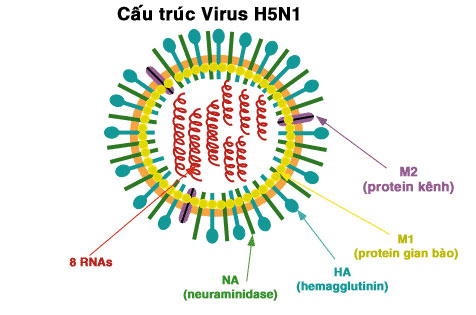
What is Swine Influenza?
Swine Influenza (swine flu) is a respiratory disease of pigs caused by type A influenza virus that regularly causes outbreaks of influenza in pigs. Swine flu viruses do not usually infect humans, but rare human infections have occurred. (For more information about swine influenza infections in humans, see Variant Influenza Viruses in Humans). Swine flu viruses can cause high levels of illness in pig herds, but cause few deaths in pigs. Swine influenza viruses can circulate among swine throughout the year, but most outbreaks occur during the late fall and winter months similar to outbreaks in humans.
How many swine flu viruses are there?
Like influenza viruses in humans and other animals, swine flu viruses change constantly. Pigs can be infected by avian influenza and human influenza viruses as well as swine influenza viruses. When influenza viruses from different species infect pigs, the viruses can reassort (i.e. swap genes) and new viruses that are a mix of swine, human and/or avian influenza viruses can emerge. Over the years, different variations of swine flu viruses have emerged. At this time, there are three main influenza A virus subtypes that have been isolated in pigs in the United States: h2N1, h2N2, and h4N2.
Over the years, different variations of swine flu viruses have emerged. At this time, there are three main influenza A virus subtypes that have been isolated in pigs in the United States: h2N1, h2N2, and h4N2.
How does swine flu spread among pigs?
Swine flu viruses are thought to be spread among pigs mostly through close contact and possibly from contaminated objects moving between infected and uninfected pigs. Infected swine herds, including those vaccinated against swine flu, may have sporadic disease, or may show only mild or no symptoms of infection.
What are signs of swine flu in pigs?
Signs of swine flu in pigs can include fever, depression, coughing (barking), discharge from the nose or eyes, sneezing, breathing difficulties, eye redness or inflammation, and going off feed. Some pigs infected with influenza, however, may show no signs of illness at all.
How common is swine flu among pigs?
h2N1 and h4N2 swine flu viruses are endemic among pig populations in the United States and something that the industry deals with routinely. Outbreaks among pigs normally occur in colder weather months (late fall and winter) , but can occur year round. While h2N1 swine viruses have been known to circulate among pig populations since at least 1930, h4N2 influenza viruses did not begin circulating among pigs in the United States until about 1998. The h4N2 viruses initially were introduced into the pig population from humans. However, since then the h4N2 viruses circulating in pigs have changed. The h4N2 viruses circulating in pigs now are very different from the seasonal h4N2 viruses that circulate in humans.
Outbreaks among pigs normally occur in colder weather months (late fall and winter) , but can occur year round. While h2N1 swine viruses have been known to circulate among pig populations since at least 1930, h4N2 influenza viruses did not begin circulating among pigs in the United States until about 1998. The h4N2 viruses initially were introduced into the pig population from humans. However, since then the h4N2 viruses circulating in pigs have changed. The h4N2 viruses circulating in pigs now are very different from the seasonal h4N2 viruses that circulate in humans.
Is there a vaccine for swine flu?
Just as there are influenza vaccines for people, there are specific swine influenza vaccines available for pigs.
h2N1 influenza (swine flu) and you
h2N1 influenza (swine flu) and you What is H 1 N 1 (swine flu)?
h2N1 (commonly known as “swine flu”) is a new influenza virus that causes illness in humans. This new virus was first detected in humans in the United States in April 2009. of the year. Other countries, including Mexico and Canada, are also reporting human cases of the new virus. This virus spreads from one person to another, probably in much the same way as regular seasonal flu.
of the year. Other countries, including Mexico and Canada, are also reporting human cases of the new virus. This virus spreads from one person to another, probably in much the same way as regular seasonal flu.
Why the new virus H 1 N 1 is sometimes called , “Pig influo”?
This virus was originally called “swine flu” because it was found during laboratory tests that many
The causative agents of this new virus were very similar to influenza viruses commonly seen in pigs in North America. However, further studies have shown that the detected virus differs in many ways from that which is spreading among North American pigs. It contains two genes from influenza viruses commonly found in pigs in Europe and Asia, as well as bird genes. Scientists call this virus the “quadruple reassortant.”
New Influenza H 1 N 1 in humans H 1 N 1 in the USA?
Yes.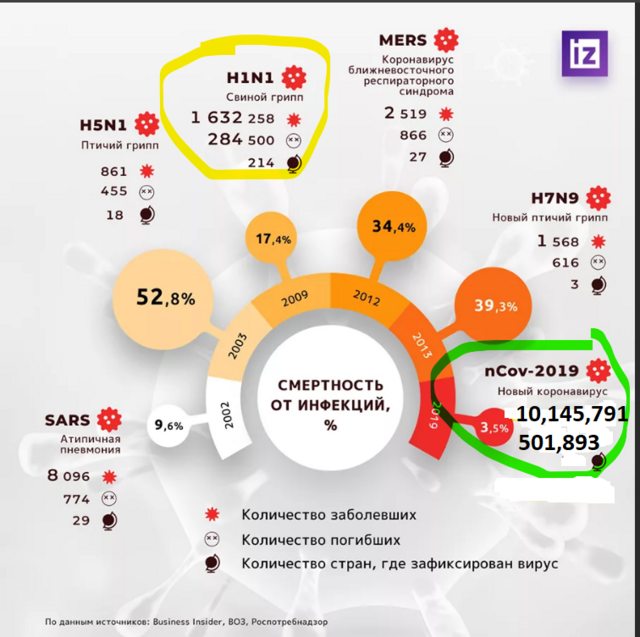 The first confirmed cases of human infection with the h2N1 influenza virus in the United States were in Southern California and near Guadalupe County, Texas. Since then, the virus has spread rapidly, with infections being reported from a growing number of states. The updated number of cases of confirmed h2N1 influenza infections in the United States is continuously reported on the Internet at http://www.cdc.gov/h2n1flu/investigation.htm . The Centers for Disease Control and Prevention (CDC) is working with local and state health agencies to investigate the situation.
The first confirmed cases of human infection with the h2N1 influenza virus in the United States were in Southern California and near Guadalupe County, Texas. Since then, the virus has spread rapidly, with infections being reported from a growing number of states. The updated number of cases of confirmed h2N1 influenza infections in the United States is continuously reported on the Internet at http://www.cdc.gov/h2n1flu/investigation.htm . The Centers for Disease Control and Prevention (CDC) is working with local and state health agencies to investigate the situation.
Is this new virus infectious?
CDC has determined that the new h2N1 virus is contagious and spreads from one person to another. However, at the moment there is no information on how easily this virus spreads between people.
What are the main signs and symptoms of this virus in humans?
The symptoms of the new h2N1 influenza virus are similar to those of the seasonal flu.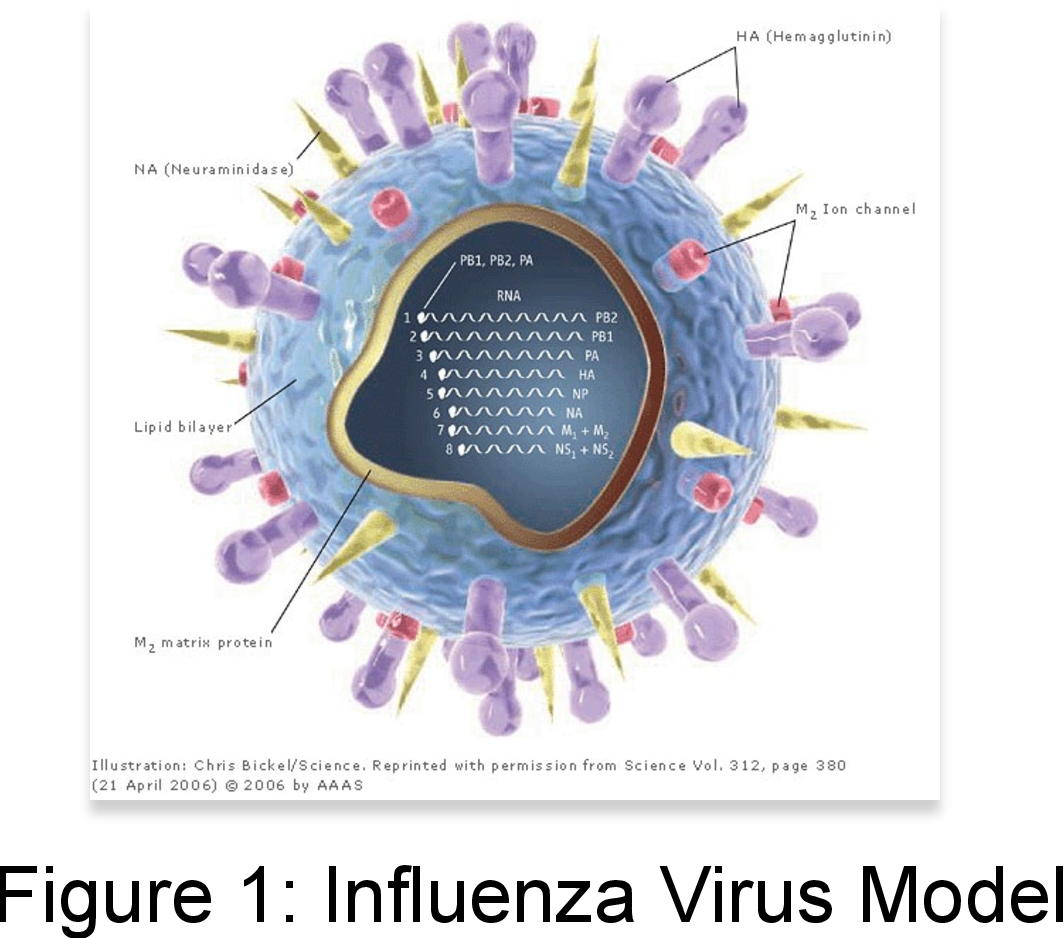 These include high fever, cough, sore throat, runny or stuffy nose, body aches, headache, chills, and feeling tired.
These include high fever, cough, sore throat, runny or stuffy nose, body aches, headache, chills, and feeling tired.
Many of the infected patients also complained of diarrhea and vomiting. In addition, as with seasonal influenza, serious and even fatal cases have been recorded as a result of the disease caused by this virus.
How serious is the disease associated with the new influenza virus 1?
It is currently unknown how dangerous this new h2N1 influenza virus will become to the general population. During seasonal flu, there are certain populations that are at greater risk for serious complications . These include people aged 65 and over, children under five, pregnant women, and people of all ages with certain chronic conditions. Initial data indicate that pregnancy and other pre-existing chronic conditions such as asthma and diabetes, which increase the risk of influenza-related complications, are also associated with an increased risk of complications from infection with this new h2N1 influenza virus.
The only thing that seems to be different from seasonal influenza is that adults over 64 years of age in this outbreak still do not appear to be at increased risk of complications from the new h2N1 influenza virus. The CDC is also conducting laboratory tests to determine if any people have natural immunity to this virus based on their age. Early reports indicate that children do not and few adults under 60 have antibodies to the novel h2N1 influenza virus; however, about a third of adults over 60 may have antibodies against this virus. It is not known how much protection against the new influenza virus type h2N1 can (if at all) provide any of the available antibodies.
What is the severity and incidence of the new influenza H 1 N 1 compared to seasonal influenza?
The CDC is still investigating the severity of illness caused by the new h2N1 influenza virus. There is currently insufficient information to predict how severe this novel h2N1 influenza virus outbreak will be in terms of morbidity and mortality, or how it will compare to seasonal influenza.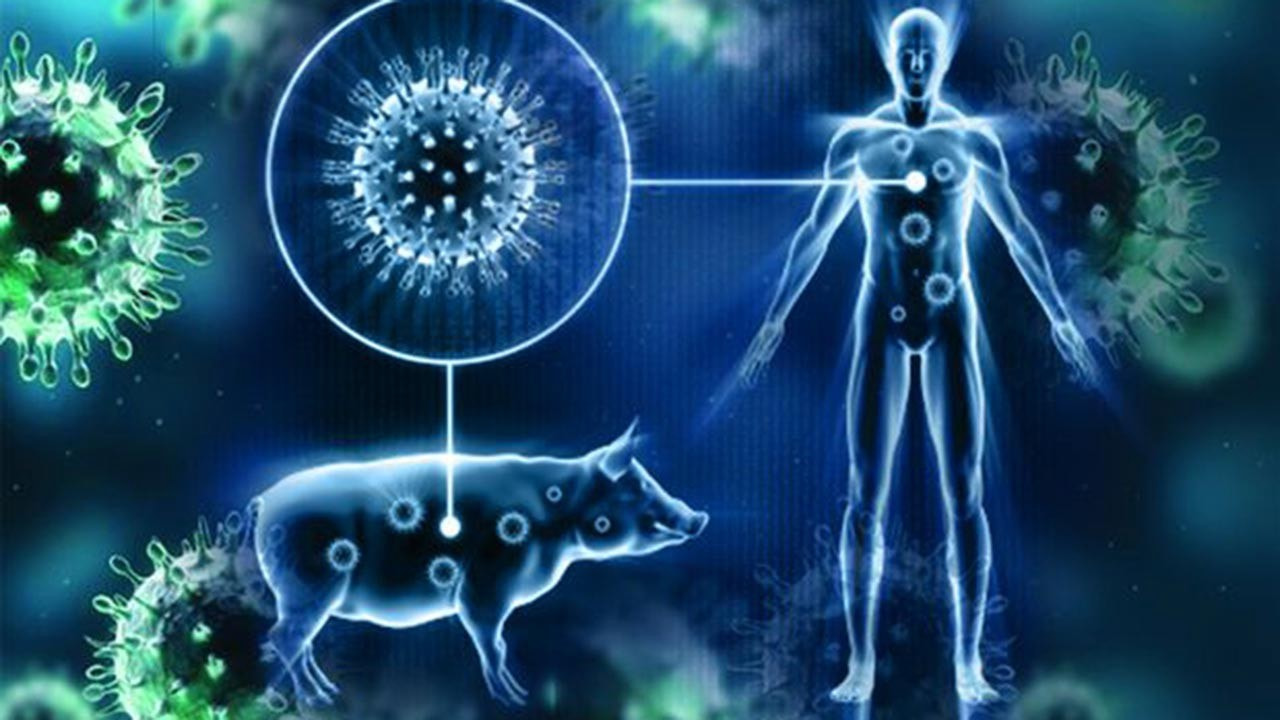
In the case of seasonal influenza, we know that the seasons vary in time, length and severity. Seasonal influenza can cause mild to severe illness, sometimes leading to death. Each year in the United States, on average, 36,000 people die from flu-related complications and more than 200,000 people are hospitalized for flu-related causes. Among those hospitalized, 20,000 are children under the age of 5. More than 90% of deaths and about 60% of hospitalizations occur in people over 65 years of age.
To date, the largest number of confirmed and probable cases of novel h2N1 influenza virus are among people aged 5 to 24 years. Currently, there are no deaths and only a few cases in people over 64 years of age, which is unusual when compared with seasonal flu. However, pregnancy and other previously established chronic illnesses with a high risk of complications from seasonal influenza appear to be associated with an increased risk of complications from this new h2N1 influenza virus.
How is the new virus transmitted H 1 N 1?
The transmission of the new h2N1 virus is believed to be identical to that of seasonal influenza. Influenza viruses are mainly transmitted from one person to another during the coughing or sneezing of sick people. Some people can get sick by touching objects that contain flu viruses and then touching their own mouth or nose.
How long can an infected person transmit the virus to other people?
The CDC currently considers this virus to have the same spreading properties as seasonal flu viruses. Studies of seasonal influenza have shown that a person can be contagious from 1 day before symptoms appear to 7 days after onset. Children, especially younger children, may be potential carriers of the virus for a longer period of time. CDC staff are studying the virus and its characteristics for more information about it, which will be provided as soon as possible.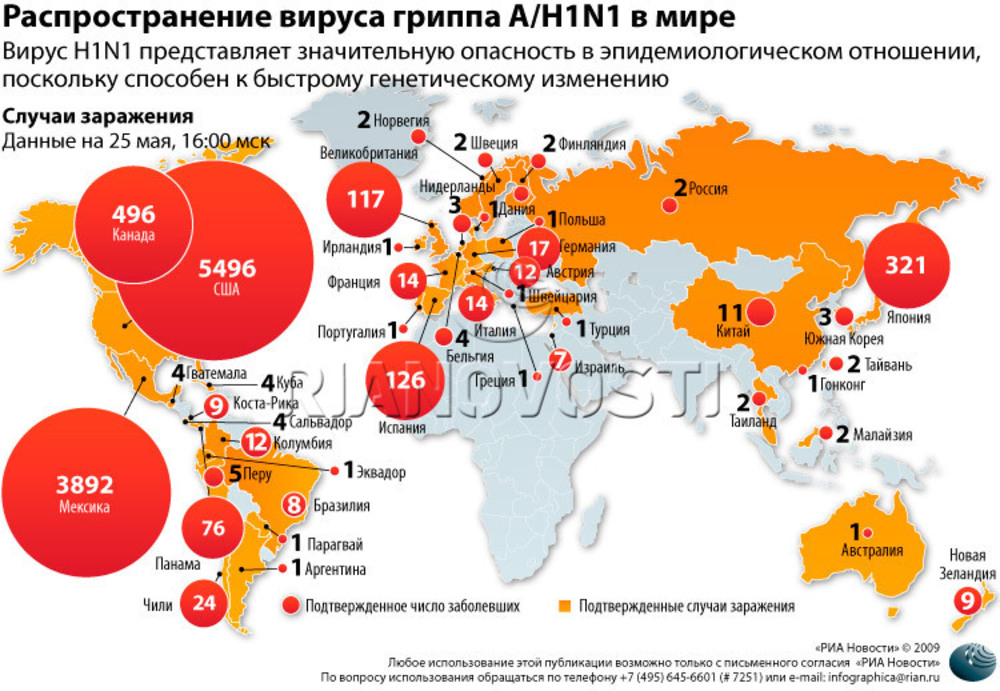
Ways not believed to be transmitted new influenza virus H 1 N 1
Can I get this new virus H 1 N 1 004 food or cook pork?
No. h2N1 viruses are not foodborne. Infection with the new HIN1 virus through pork or pork products is not possible. Properly processed and cooked pork products are completely safe to consume.
Is there a risk of disease through drinking water?
Tap water that has been treated with accepted disinfection methods does not pose a particular risk of transmitting influenza viruses. Current standards for the treatment of drinking water provide a high degree of protection against viruses. The susceptibility of the new h2N1 influenza virus to accepted drinking water treatment processes has not been studied. However, recent studies have shown that the level of free chlorine commonly used to purify drinking water is sufficient to inactivate the highly pathogenic H5N1 avian influenza.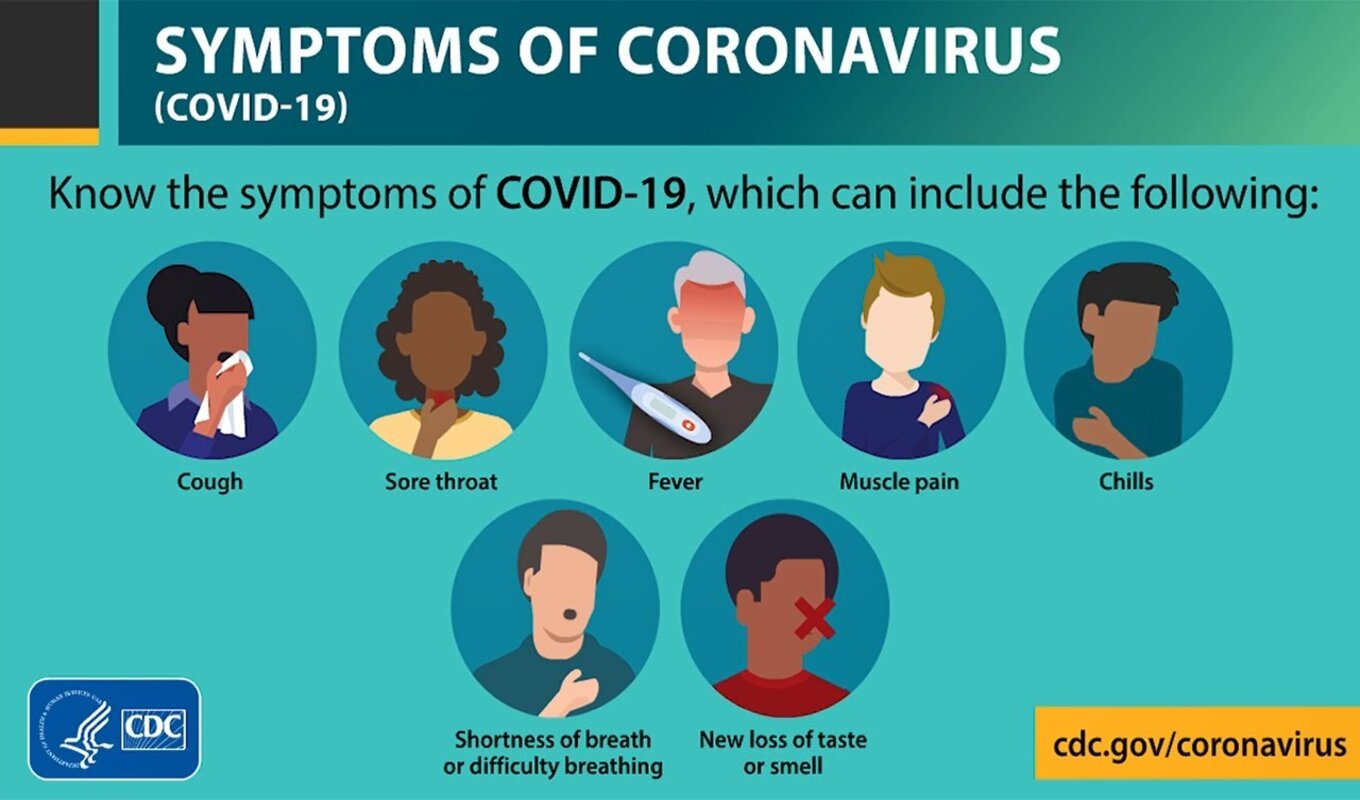 It is likely that other influenza viruses, such as the new h2N1, will also be inactivated by chlorine treatment. To date, there have been no documented cases of influenza caused by contaminated drinking water.
It is likely that other influenza viruses, such as the new h2N1, will also be inactivated by chlorine treatment. To date, there have been no documented cases of influenza caused by contaminated drinking water.
Can a new flu virus H 1 N 1 spread through water in swimming pools, spas, water parks, fountains and other 90 003 treated water sources used for bathing and swimming?
Influenza viruses infect the human upper respiratory tract. There are no documented cases of influenza virus infection associated with water use. Bathing and swimming water that has been treated using CDC-recommended disinfection levels is unlikely to transmit influenza viruses. The susceptibility of the h2N1 influenza virus to chlorine and other disinfectants used in swimming pools, spas, water parks, fountains, and other treated water sources used for bathing and swimming has not been studied. However, recent studies have shown that CDC-recommended levels of free chlorine (1-3 parts per million [ppm or mg/L] for swimming pools and 2-5 ppm for spas) are sufficient to disinfect avian influenza A (H5N1) virus.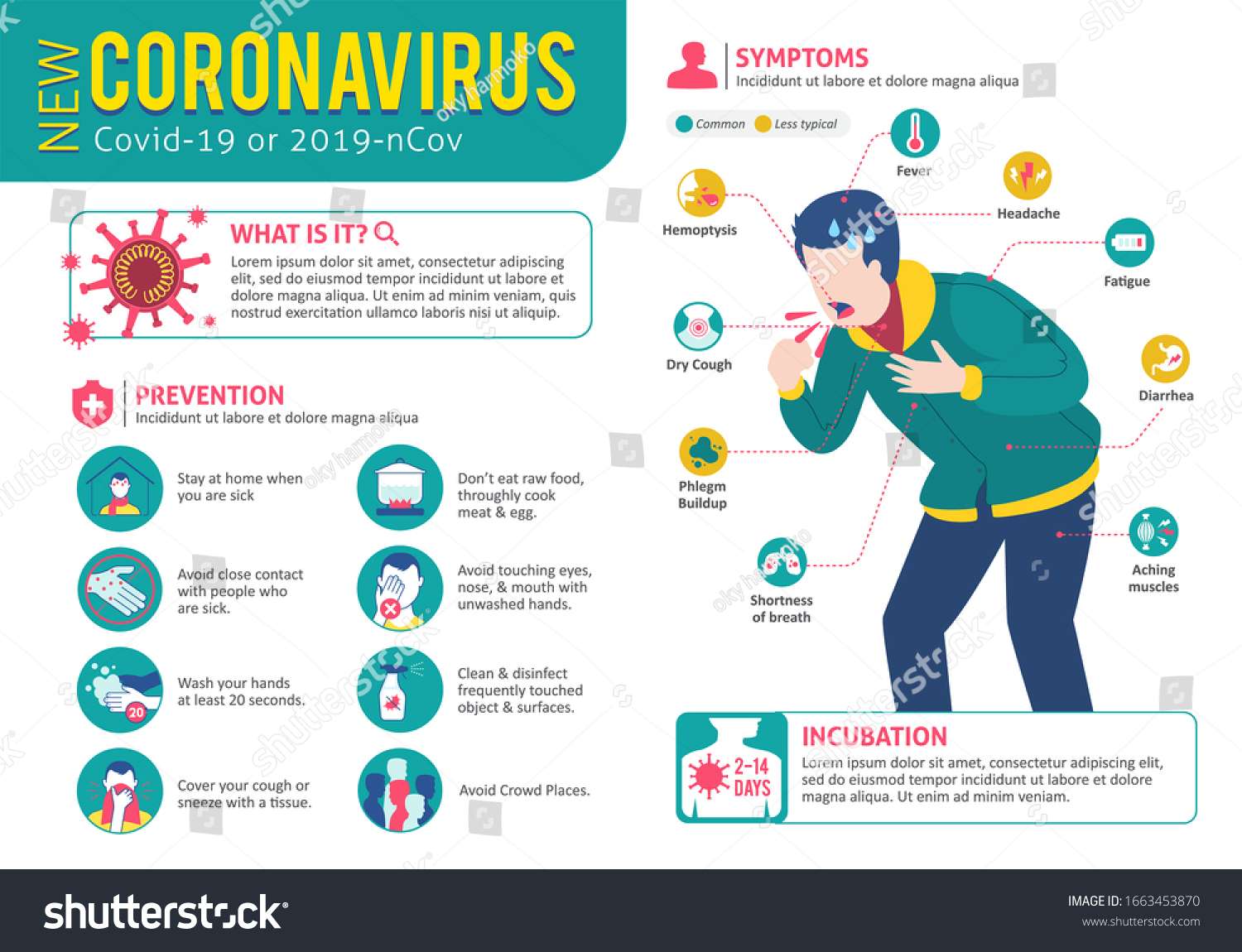 It is likely that other influenza viruses, such as the new h2N1, will also be disinfected with chlorine.
It is likely that other influenza viruses, such as the new h2N1, will also be disinfected with chlorine.
Can influenza virus H 1 N 1 be transmitted in watery areas, 9000 3 used for bathing and swimming, outside of it?
Yes, bathing and swimming pools are no different from other public places. The modes of transmission of the new h2N1 virus are believed to be identical to those of the seasonal flu. Influenza viruses are mainly transmitted from one person to another during the coughing or sneezing of sick people. Some people can get sick by first touching an object that contains flu viruses and then touching their own mouth or nose.
Prevention and treatment
How can I protect myself from infection?
There is currently no vaccine to protect against infection with the novel h2N1 virus. To prevent the spread of respiratory illnesses such as the flu, normal daily hygiene practices should be followed.
To protect your health, use the following measures:
• Cover your nose and mouth with a tissue when you cough or sneeze. Throw away the used tissue in the trash.
• Wash your hands thoroughly and often with soap and water, especially after coughing or sneezing. Alcohol-based hand sanitizers are also effective.
• Do not touch your eyes, nose or mouth. The infection is transmitted in this way.
• Avoid close contact with sick people.
• If you are ill, stay home for 7 days after symptoms develop or until symptoms develop within 24 hours, whichever is longer. This is necessary to prevent infecting others and further spread of the virus.
Other important things you can do include:
• Follow public health guidelines for school closures, social distancing, and other flu isolation measures.
• Be prepared to stay at home for about a week if you become ill; A supply of over-the-counter medications, alcohol-based hand rubs, tissues, and other related items may come in handy to help eliminate the need to go out in public while you are sick and carrying an infection.
What is the best way to protect yourself from spreading the virus through coughing or sneezing?
If you are sick, limit contact with other people as much as possible. If you become ill, stay home for 7 days after symptoms develop or until symptoms develop within 24 hours, whichever is longer. Cover your mouth and nose with a tissue when you cough or sneeze. Throw used tissues in the trash can. Afterward, wash your hands after every bout of coughing or sneezing.
What is the best way to wash your hands to avoid getting the flu?
Washing your hands frequently will protect you from germs. Use soap or an alcohol-based hand rub to wash your hands. The CDC recommends washing your hands — with soap and warm water — for at least 15 to 20 seconds. If soap and water are not available, disposable wipes soaked in alcohol-based hand rub or disinfectant gels can be used. They can be found in most supermarkets and pharmacies.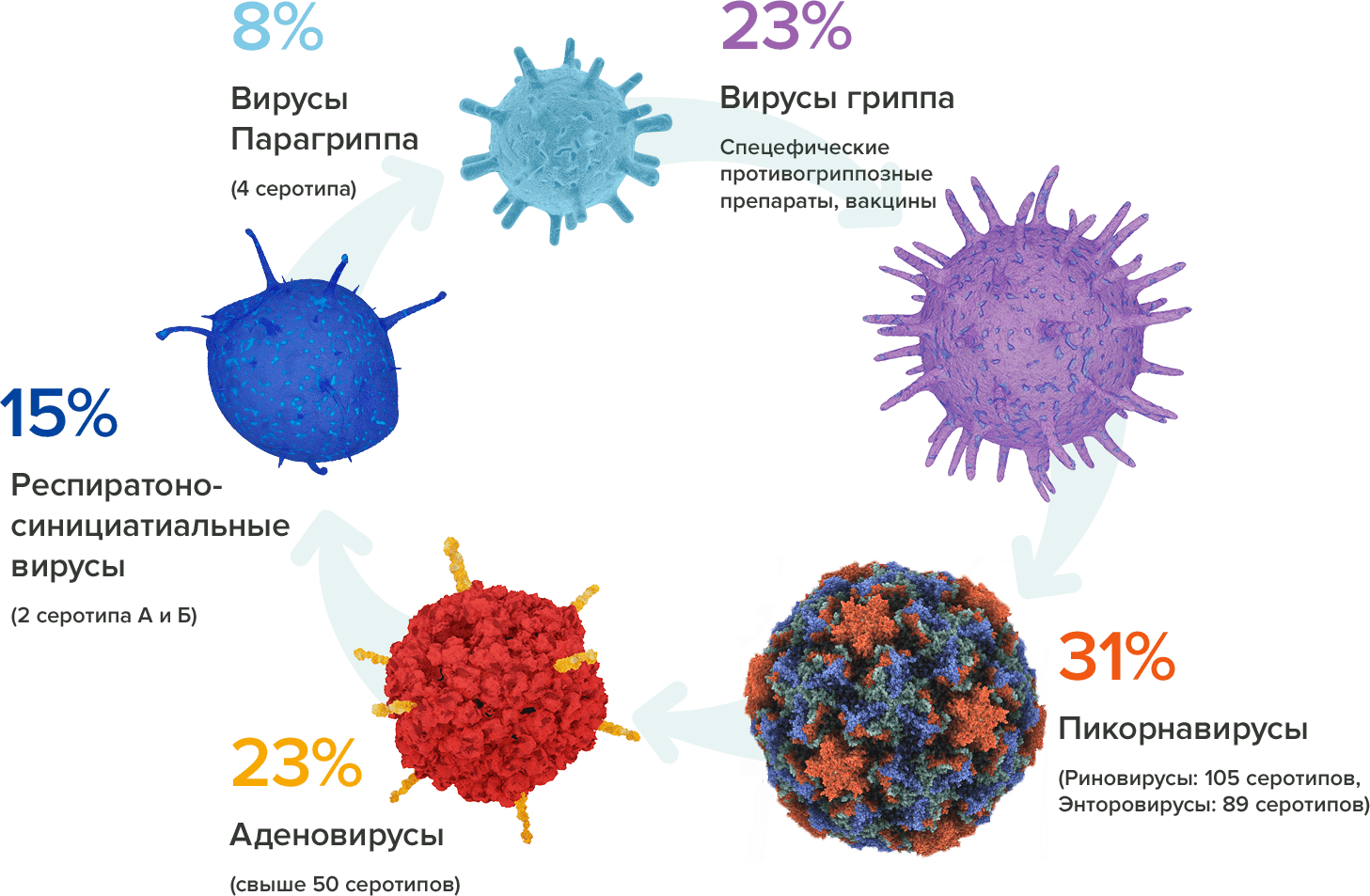 When using the gel, rub it into your hands until completely dry. The gel does not require water to act; the alcohol it contains will kill the germs on your hands.
When using the gel, rub it into your hands until completely dry. The gel does not require water to act; the alcohol it contains will kill the germs on your hands.
What should I do if I get sick?
If you live in areas where cases of novel h2N1 flu have been identified and you have flu-like symptoms, including fever, body aches, runny or stuffy nose, sore throat, nausea, vomiting, or diarrhea, stay home and avoid contact with other people. Staying at home means not leaving it, except when you need to seek medical help. This means avoiding normal activities including work, school, travel, shopping, social events and public gatherings.
If you are seriously ill or especially susceptible to complications from the flu, contact your healthcare provider or seek medical attention. The health facility will determine if flu testing is needed or if treatment is needed right away. If you get sick and have any of the following signs that your condition is getting worse, call your doctor right away.
In children among similar signs that require urgent care, may include:
• Rapid or labored breathing
• Gray or bluish skin
• Not drinking enough water
9000 6 • Severe or persistent vomiting
• Not awakening or not responding
• So agitated that the child resists being picked up
• Some improvement in flu symptoms, which then returned, followed by fever and increased cough
In adults, signs that require immediate medical attention may include the following:
Difficulty breathing or shortness of breath Pain or tightness in the chest or abdomen
Sudden dizziness
Confusion
Severe or persistent vomiting
Some relief from influenza symptoms which then returned, accompanied by fever and increased cough
Are there medicines to treat the new flu?
Yes. The CDC recommends the use of oseltamivir or zanamivir to treat and/or prevent infection with the novel h2N1 influenza virus. Antiviral drugs are prescription drugs (tablets, solutions, or inhalers) that are designed to treat the flu and stop viruses from multiplying in your body. If you get sick, antiviral medicines can slow down the progression of the disease and help you feel better sooner. In addition, they can prevent serious complications caused by the flu. During the current epidemic, the use of anti-influenza antiviral drugs for the treatment of serious influenza is a priority.
Antiviral drugs are prescription drugs (tablets, solutions, or inhalers) that are designed to treat the flu and stop viruses from multiplying in your body. If you get sick, antiviral medicines can slow down the progression of the disease and help you feel better sooner. In addition, they can prevent serious complications caused by the flu. During the current epidemic, the use of anti-influenza antiviral drugs for the treatment of serious influenza is a priority.
What is the CDC recommendation for swine flu parties?
“Swine flu parties” are gatherings where people come into close contact with someone who has the novel h2N1 flu in order to become infected with the virus. The purpose of these parties is to be infected with the virus that has caused many people mild illness, in the hope of acquiring natural immunity to the new h2N1 influenza virus that may continue to circulate and cause more severe illness.
The CDC does not recommend “swine flu parties” as a way to protect against the new h2N1 influenza in the future.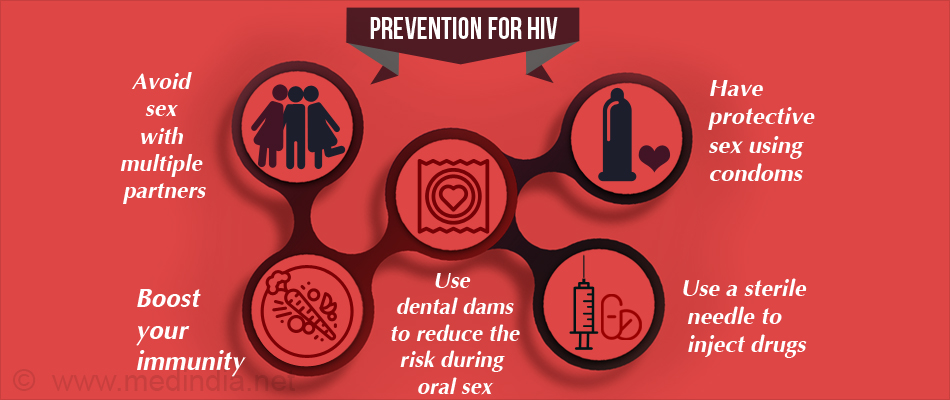 While the illness seen in the current outbreak of the new h2N1 influenza virus is mild in many people, it is severe and even fatal in others. It is impossible to predict with certainty what the outcome will be in the case of a person, or, just as importantly, in the case of those to whom a person who deliberately infects himself can transmit the virus.
While the illness seen in the current outbreak of the new h2N1 influenza virus is mild in many people, it is severe and even fatal in others. It is impossible to predict with certainty what the outcome will be in the case of a person, or, just as importantly, in the case of those to whom a person who deliberately infects himself can transmit the virus.
The CDC recommends that people with the new h2N1 flu virus avoid contact with others as much as possible. They should stay home for 7 days after symptoms develop or until symptoms develop within 24 hours, whichever is longer.
Infection and cleaning
x (e.g. books and doorknobs)?
Studies have shown that influenza virus
is able to survive on surrounding objects with the possibility of infecting a person within 2-8 hours from the moment it hits the surface.
What kills the influenza virus?
Influenza virus is destroyed by high temperature (75-100°C). In addition, some chemical germicides, including chlorine, hydrogen peroxide, detergents (soaps), iodophors (iodine-based antiseptics), and alcohol solutions, are effective against human influenza viruses when used at the appropriate concentration for a sufficient period of time. For example, alcohol-based hand rubs and gels can be used to clean hands. Gels must be rubbed into the hands until completely dry.
In addition, some chemical germicides, including chlorine, hydrogen peroxide, detergents (soaps), iodophors (iodine-based antiseptics), and alcohol solutions, are effective against human influenza viruses when used at the appropriate concentration for a sufficient period of time. For example, alcohol-based hand rubs and gels can be used to clean hands. Gels must be rubbed into the hands until completely dry.
Which surfaces are more likely to be contaminated?
Germs can be spread when a person touches germ-bearing objects and then touches their eyes, nose, or mouth. Droplets of liquid during an infected person’s sneeze or cough are transmitted through the air. Germs can be transmitted when a person touches another person’s respiratory droplets on a surface, such as a table, and then touches their own eyes, mouth, or nose without washing their hands.
How should household waste be handled to prevent the spread of the influenza virus?
To prevent the spread of influenza virus, it is recommended that tissues and other disposable items used by an infected person be thrown into the trash. In addition, after touching tissues and similar debris, wash your hands with soap and water.
In addition, after touching tissues and similar debris, wash your hands with soap and water.
What to wash in the house for prevent the spread of the flu virus?
To prevent the spread of the influenza virus, it is important to keep surfaces (especially bedside tables, bathrooms, kitchens, and children’s toys) clean by wiping them down with household disinfectants according to label directions.
How should linen, cutlery and crockery used by people infected with the influenza virus be handled?
It is not necessary to wash linen and cutlery and dishes belonging to the patient separately, but it is important to remember that these items should not be used by others without careful pretreatment. Linens (such as sheets and towels) should be washed using regular laundry soap and dried in a hot dryer. Do not carry dirty linen “in an armful” to the place of washing in order to prevent your own infection.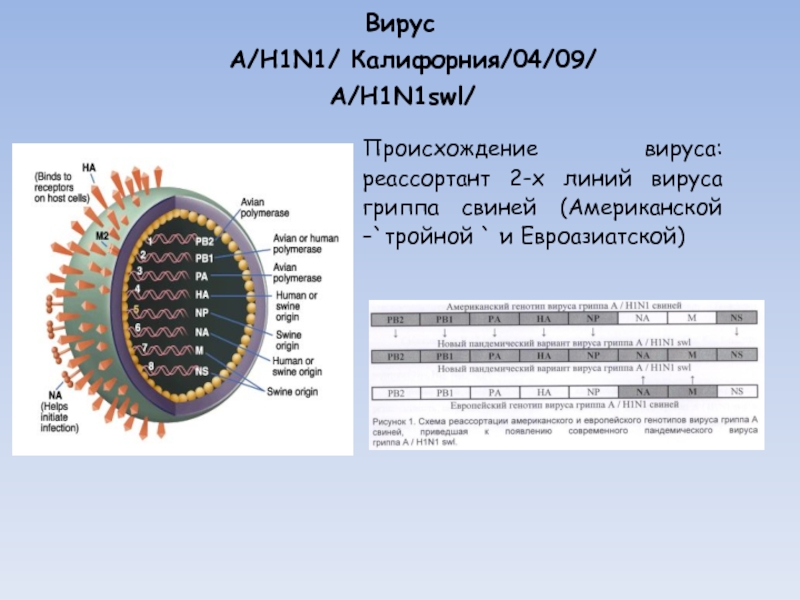 After carrying dirty laundry, wash your hands with soap and water or wipe them with an alcohol-based hand rub.
After carrying dirty laundry, wash your hands with soap and water or wipe them with an alcohol-based hand rub.
Cutlery should be washed either in the dishwasher or with soap and water.
Response and research
What is CDC doing in response to the influenza outbreak?
The purpose of this institution is to reduce the spread and severity of the disease, and to provide information to help physicians, health care administrators and the public in informing them about the issues raised by the new virus. The CDC is working with state and local health departments to strengthen surveillance in the United States and collect and analyze data to assess the impact of the virus and identify groups at higher risk of developing complications. In addition to this, CDC continues to release new and updated interim guidance for healthcare professionals, health professionals and the public for the prevention and treatment of this new virus.
To expand national and international laboratory capacity to detect novel h2N1 influenza, CDC has developed and distributed new diagnostic kits and reagents to more than 350 laboratories, including laboratories in 131 countries. The Center’s Strategic National Stockpile (SNS) division continues to ship antiviral drugs, personal protective equipment, and respiratory protection to all 50 states and other US territories to assist in the outbreak response.
The United States government is also actively taking early steps in the production of the new h2N1 influenza vaccine by working closely with manufacturers. The CDC has isolated a new h2N1 type virus, created a candidate vaccine virus that can be used to produce a vaccine, and made the virus available to manufacturers, who can therefore start scaling up vaccine production if necessary.
What epidemiological studies are being carried out in response to the current influenza outbreak?
The CDC is working closely with local and state officials in areas where there have been identified cases of novel h2N1 influenza infection in the public. The CDC has sent staff to several states to help conduct research on the impact of the new h2N1 influenza virus, including assessing the severity of the illness, how easily the virus spreads, and the amount of time people can be contagious. In states where EpiAid teams have been deployed, various epidemiological measures are in place or planned, including:
The CDC has sent staff to several states to help conduct research on the impact of the new h2N1 influenza virus, including assessing the severity of the illness, how easily the virus spreads, and the amount of time people can be contagious. In states where EpiAid teams have been deployed, various epidemiological measures are in place or planned, including:
• Continuous surveillance in those counties where human cases have been identified;
• Examination of health care workers who have been in contact with sick patients to determine if they are infected;
• Examining family members and others who have been in contact with sick patients to see if they are infected;
• A study to find out how long a person infected with a virus sheds the virus into the environment.
Who is responsible for distributing medicines from national strategic stockpiles (SNZ) after delivery?
Local health authorities have full control over the distribution of CHS medicines after they are delivered to a city, state, or region.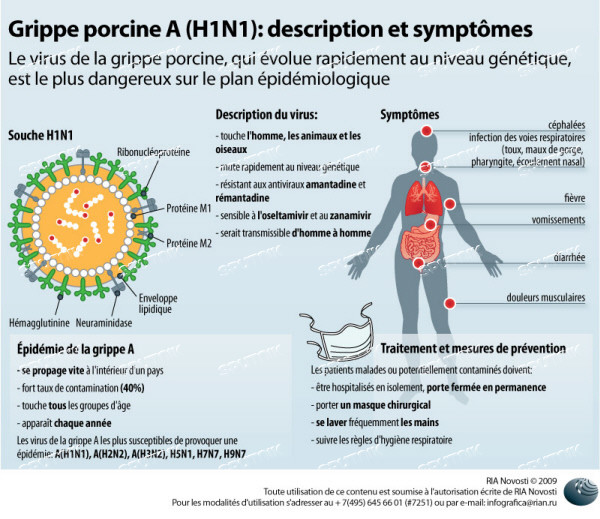 Federal, local, and state planners are working closely together to ensure that NHS drugs reach affected areas as quickly as possible. CHS medicines have already been delivered to many cities, states and regions. Once CDC arranges for the shipment of drugs to a state or city, all control and distribution of drugs is at the discretion of the local health authority or appropriate state department. In addition, most states and cities have their own stock of drugs that can be used to treat infected patients.
Federal, local, and state planners are working closely together to ensure that NHS drugs reach affected areas as quickly as possible. CHS medicines have already been delivered to many cities, states and regions. Once CDC arranges for the shipment of drugs to a state or city, all control and distribution of drugs is at the discretion of the local health authority or appropriate state department. In addition, most states and cities have their own stock of drugs that can be used to treat infected patients.
*Note: Most of the information contained in this document is based on research and experience gained from the treatment of seasonal (human) influenza. CDC experts believe that this information also applies to the new (“pork”) virus H 1 N 1 e ), but research in this area is still ongoing to obtain for more information about the features of this disease. As new information becomes available this document will be updated.
For general information about swine flu (not new h2N1 flu), see Reference about swine flu . (BackgroundInformationaboutSwineInfluenza)
ways of transmission, signs, prevention – MBUZ City polyclinic 12 Krasnodar
Millions of people fall ill every year with influenza and other acute respiratory viral infections (ARVI or, as they say, ARI). These infections affect up to 80% of the population every year. The most severe forms of influenza and acute respiratory infections are observed, first of all, in the elderly and children under one year old. These infections cause enormous damage to public health and sometimes lead to serious complications. Hundreds of people die every year from the flu and its complications.
Due to the high level of antigenic variability in circulating viruses, immunity to viruses that circulate in the current year may not be effective against viruses that begin to circulate next. Annual epidemic outbreaks of influenza are explained precisely by the high level of variability of the virus.
Annual epidemic outbreaks of influenza are explained precisely by the high level of variability of the virus.
Ways of transmission
During sneezing, as well as when coughing, the smallest particles of saliva and sputum fly out of the mouth of a sick person, in which viruses are contained in huge quantities. Therefore, the main mechanism for the transmission of influenza and SARS is called – airborne. Another mechanism of respiratory infection transmission is contact. It has long remained unproven and less obvious than airborne. However, it plays an equally, and perhaps even greater role in the spread of colds. It happens like this. As a rule, a person who sneezes or coughs covers his mouth with his hand, hoping to prevent the spread of infection by airborne droplets. At the same time, he does not suspect how much it simplifies the transmission of his infection by contact. The fact is that the entire colossal mass of microbes that was supposed to go out into the open space settles on the hand of a sneezing or coughing person. Which safely carries it to household items, including those that other people touch. Or he carries it on the hands of friends, colleagues and acquaintances with handshakes. Those, in turn, only have to touch their mouth, nose, or wipe their eyes, which are also lined with mucosa susceptible to SARS, and the complex airborne transmission route is reduced tenfold for the virus in time and complexity. That’s why it’s important to wash your hands and avoid touching your own face with your hands during outbreaks of respiratory infections.
Which safely carries it to household items, including those that other people touch. Or he carries it on the hands of friends, colleagues and acquaintances with handshakes. Those, in turn, only have to touch their mouth, nose, or wipe their eyes, which are also lined with mucosa susceptible to SARS, and the complex airborne transmission route is reduced tenfold for the virus in time and complexity. That’s why it’s important to wash your hands and avoid touching your own face with your hands during outbreaks of respiratory infections.
To this it should be added that the causative agents of ARVI are quite stable in the external environment. Thus, the influenza virus can remain viable outside the body for up to 3 weeks. Therefore, infection can occur even after a considerable time after contact of a sick person with household items, children’s toys, dishes, door handles of public institutions, etc. On the other hand, for the successful introduction of the virus into the body, another factor is important – the number of viral particles that enter the body.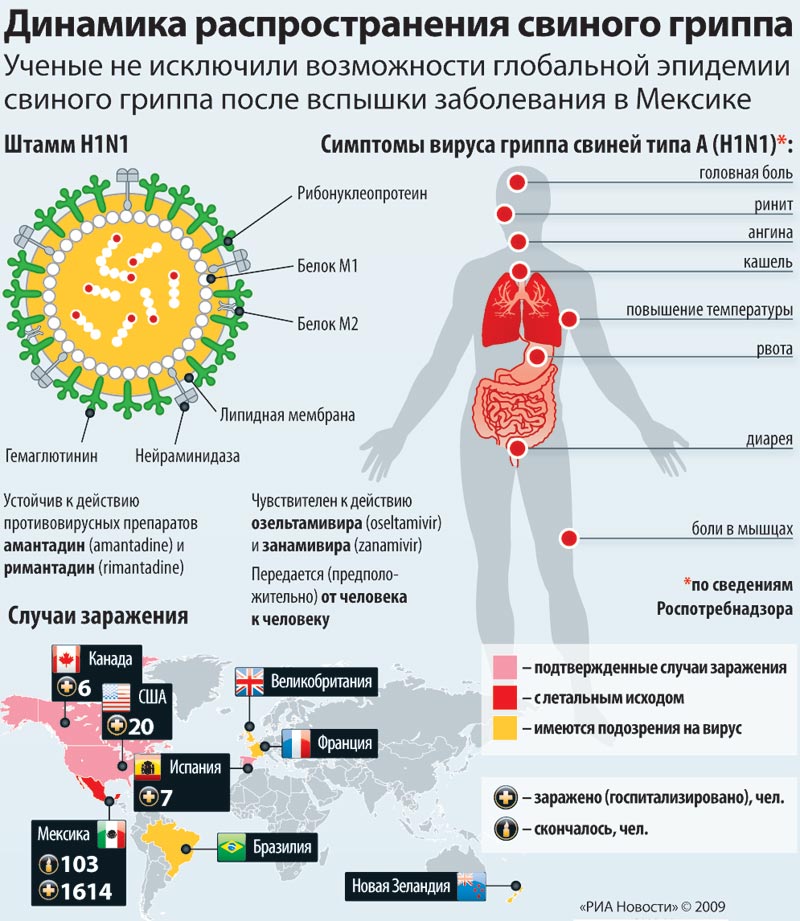 The smaller it is, the less likely it is that the protective barriers of the body will be overcome and a disease will occur. A high concentration of viruses can persist indoors, especially with large crowds of people: offices, schools, kindergartens, public transport, shops. On the contrary, in the open air it is almost impossible to meet a sufficient number of microbial particles for infection. Therefore, contrary to popular belief, even during a seasonal outbreak of SARS, it is absolutely not dangerous to walk outdoors . Much more important is what transport you use to get to the place of walking or work.
The smaller it is, the less likely it is that the protective barriers of the body will be overcome and a disease will occur. A high concentration of viruses can persist indoors, especially with large crowds of people: offices, schools, kindergartens, public transport, shops. On the contrary, in the open air it is almost impossible to meet a sufficient number of microbial particles for infection. Therefore, contrary to popular belief, even during a seasonal outbreak of SARS, it is absolutely not dangerous to walk outdoors . Much more important is what transport you use to get to the place of walking or work.
Signs of the disease, principles of treatment
After the pathogen has entered the body, it takes time for it to overcome the protective barriers of the body and begin to multiply in sufficient quantities, exerting its effect on the body. This time is called the incubation period. For SARS, the duration of the incubation period ranges from several hours to 3 days, on average 2 days, and depends on the aggressiveness of the virus, the number of viral particles and the state of the protective forces of the respiratory system.
Further, the clinical picture of ARVI begins to gradually develop. It can be divided into 2 syndromes – catarrhal and intoxication. Catarrhal syndrome is the result of lesions of the mucous membranes and manifests itself as follows: dryness, sore throat and sore throat, cough, nasal congestion, sneezing, voice change, redness of the conjunctiva, lacrimation, sometimes – photophobia.
Intoxication syndrome, as a rule, appears later than catarrhal and disappears before it, but nevertheless is more severe. The reproduction of viruses inside cells is accompanied by the formation of toxins dangerous to humans. The destruction of infected cells leads to the entry of these substances into the blood, which cause a picture of an intoxication syndrome. It manifests itself: fever, chills, pain in the joints and muscles, in more severe cases – nausea, vomiting and loss of consciousness.
Viral infections of the respiratory tract are characterized by light, transparent discharge with low viscosity (specialists call them serous).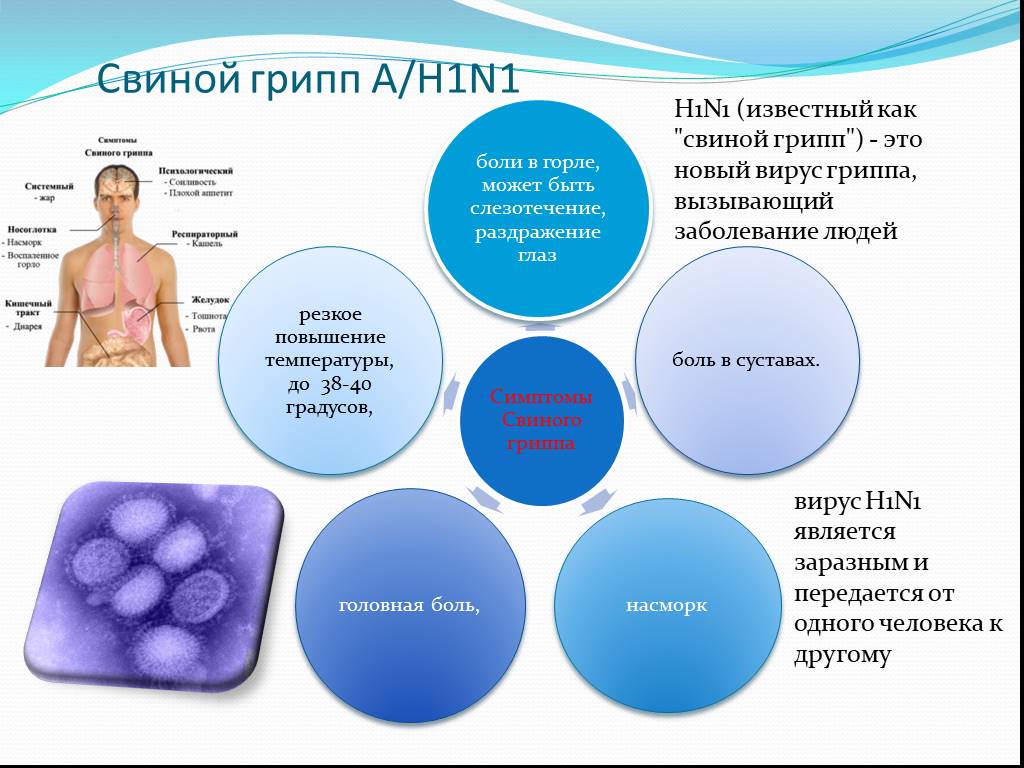 By the end of the disease, they may become yellowish. If the discharge from the nose or bronchi becomes thick, their number increases sharply, and the color becomes dark yellow, this may indicate the addition of a bacterial infection.
By the end of the disease, they may become yellowish. If the discharge from the nose or bronchi becomes thick, their number increases sharply, and the color becomes dark yellow, this may indicate the addition of a bacterial infection.
Despite the wide variety of symptoms, for most people SARS, including the flu, is a mild illness. They pose a danger to people with severe concomitant diseases: diabetes mellitus, heart failure, chronic renal failure, tuberculosis and others.
Any infection is a conflict between the human body and a pathogen. Each such conflict at the same time requires the closest attention to itself. Seeing a doctor is mandatory, it will help to make a timely diagnosis and determine adequate treatment. Antibiotics that successfully treat bacterial infections are ineffective for treating SARS. They have completely different mechanisms of action that cannot affect viruses in any way. The only case when the use of antibiotics is justified is the addition of a bacterial infection.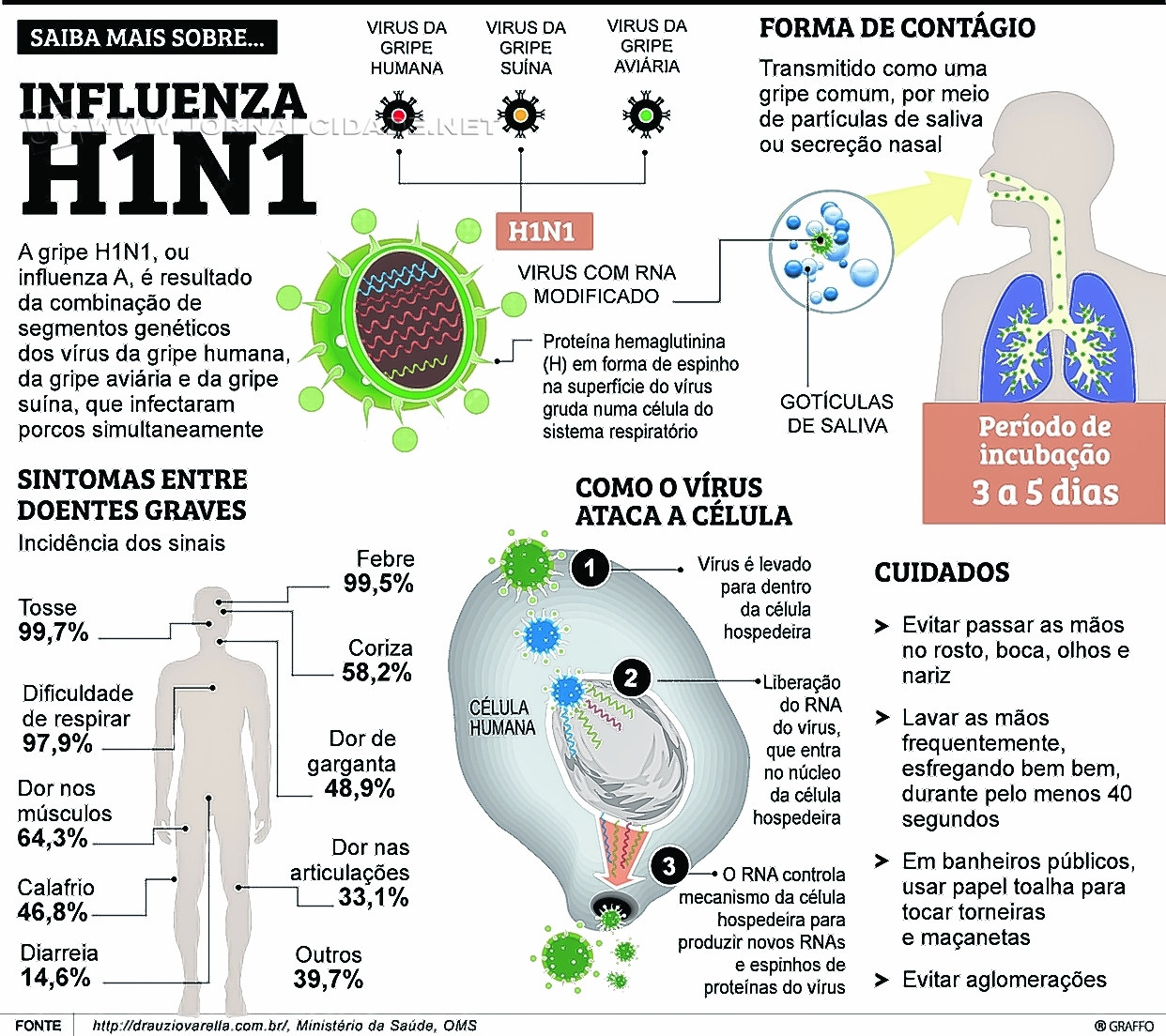 The doctor prescribes antiviral drugs, of which many are currently developed and they are selected individually. Perhaps the appointment of vitamins, detoxification and symptomatic therapy.
The doctor prescribes antiviral drugs, of which many are currently developed and they are selected individually. Perhaps the appointment of vitamins, detoxification and symptomatic therapy.
Prophylaxis
To prevent the spread of infection, should, if possible, protect the patient from contact with others. In order to reduce the release of viruses when sneezing, you can use the mask by putting it on the patient. In order for the mask to perform its protective function, it must cover both the mouth and the nose. Only in this case, it will retain droplets of liquid that fly out when sneezing, talking and coughing.
Contrary to popular belief, a mask worn by a healthy person does not act as a filter that traps viruses (it is not tight enough for this), and prevents accidental contact of a person’s hands with the mouth and nose, reducing the risk of contact transmission of infection.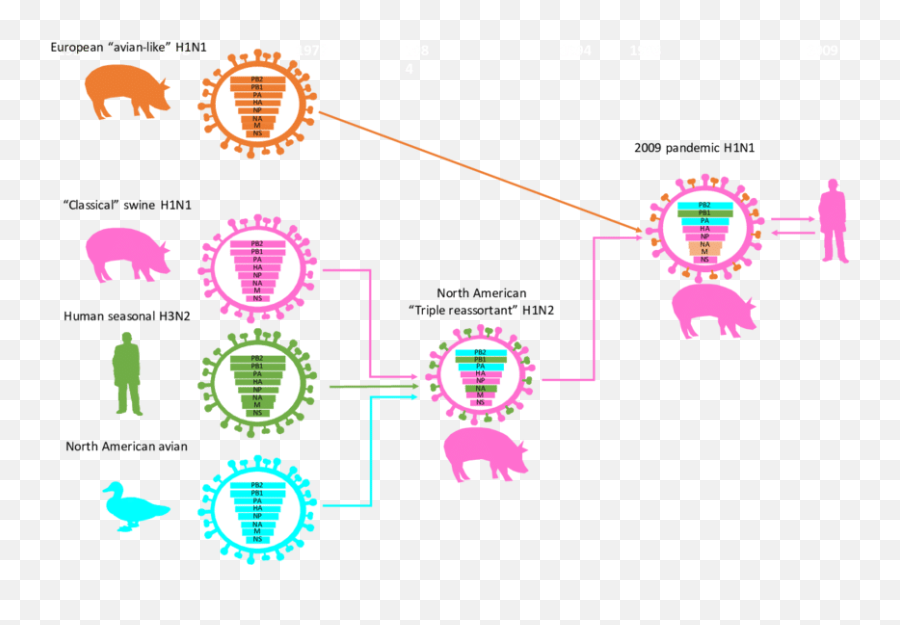


 Transmission of the influenza virus from swine to humans is usually seen in people who have a close association with pigs, such as farmers, pork handlers, and veterinarians. These individuals are strongly encouraged to wear face-masks when dealing with the animals to prevent transmission through respiratory droplets. The most important step of prevention is vaccination of the swine. Individuals with increased risk of acquiring swine flu through pigs are those who smoke and do not wear gloves or masks when dealing with infected animals, increasing the risk of possible hand-to-nose, hand-to-eye, or hand-to-mouth transmission.
Transmission of the influenza virus from swine to humans is usually seen in people who have a close association with pigs, such as farmers, pork handlers, and veterinarians. These individuals are strongly encouraged to wear face-masks when dealing with the animals to prevent transmission through respiratory droplets. The most important step of prevention is vaccination of the swine. Individuals with increased risk of acquiring swine flu through pigs are those who smoke and do not wear gloves or masks when dealing with infected animals, increasing the risk of possible hand-to-nose, hand-to-eye, or hand-to-mouth transmission.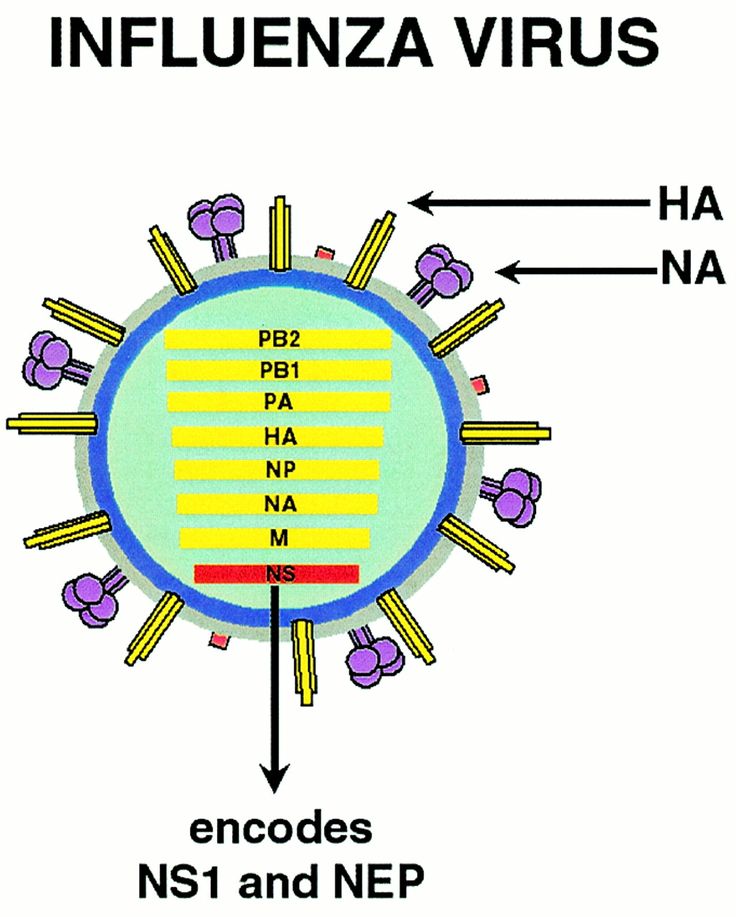 Current CDC recommendations to prevent the spread of the virus include frequent handwashing with soap and water or alcohol-based sanitizers, and also disinfecting household, hospital and public settings by cleaning with a diluted bleach solution. Anyone who resides in an area where the disease is prevalent and suspects an infection or presents with flu-like symptoms, should stay away from work and public transportation and immediately see a doctor.
Current CDC recommendations to prevent the spread of the virus include frequent handwashing with soap and water or alcohol-based sanitizers, and also disinfecting household, hospital and public settings by cleaning with a diluted bleach solution. Anyone who resides in an area where the disease is prevalent and suspects an infection or presents with flu-like symptoms, should stay away from work and public transportation and immediately see a doctor. [PMC free article: PMC6293944] [PubMed: 30613550]
[PMC free article: PMC6293944] [PubMed: 30613550]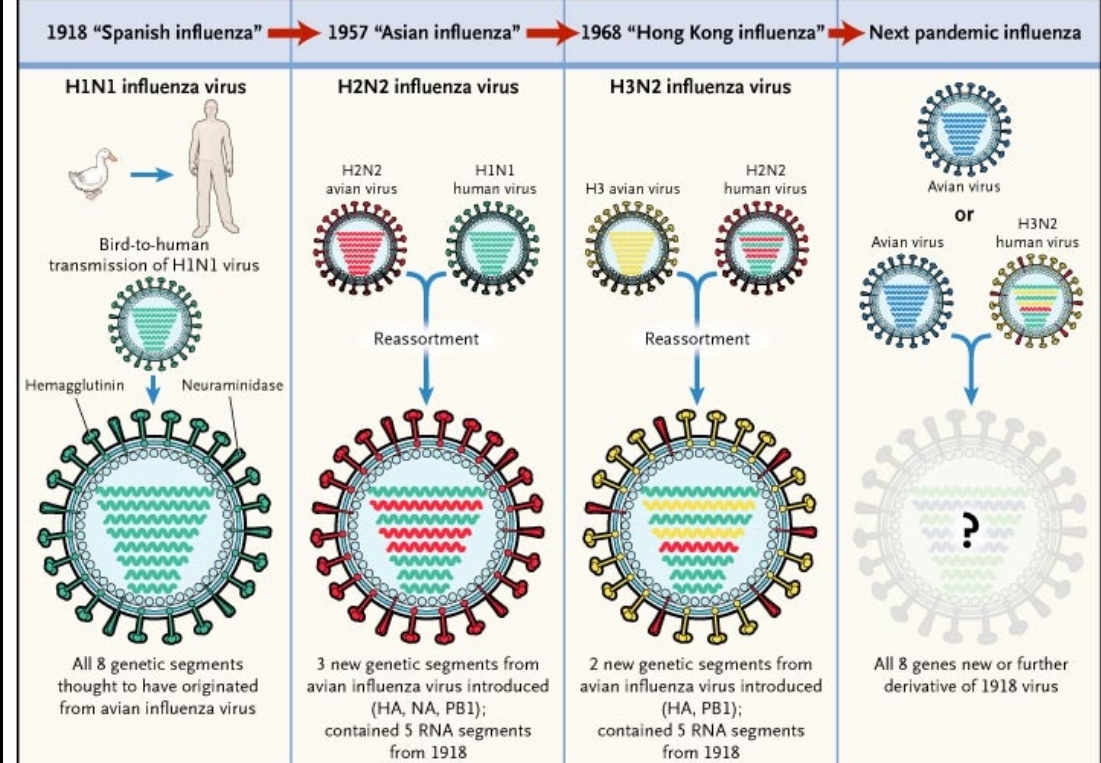 Infection of novel reassortant h2N2 and h4N2 swine influenza A viruses in the guinea pig model. Vet Res. 2018 Jul 27;49(1):73. [PMC free article: PMC6062863] [PubMed: 30053826]
Infection of novel reassortant h2N2 and h4N2 swine influenza A viruses in the guinea pig model. Vet Res. 2018 Jul 27;49(1):73. [PMC free article: PMC6062863] [PubMed: 30053826] Pathology of the swine-origin influenza A (h2N1) flu. Pathol Res Pract. 2011 Feb 15;207(2):86-90. [PubMed: 21176866]
Pathology of the swine-origin influenza A (h2N1) flu. Pathol Res Pract. 2011 Feb 15;207(2):86-90. [PubMed: 21176866] [PMC free article: PMC7106429] [PubMed: 19628172]
[PMC free article: PMC7106429] [PubMed: 19628172]